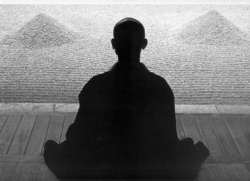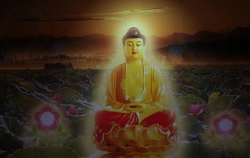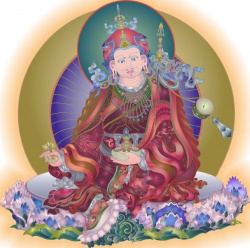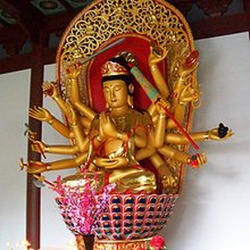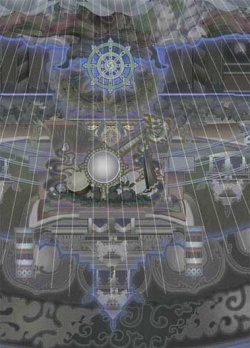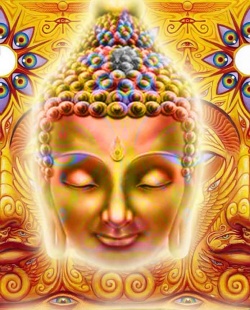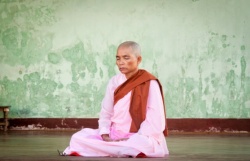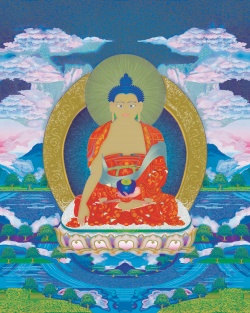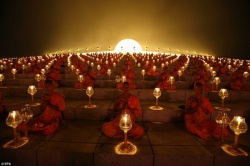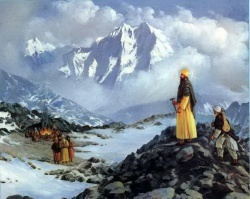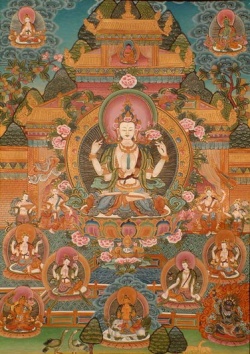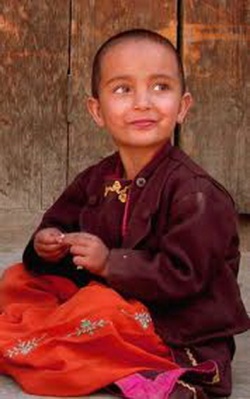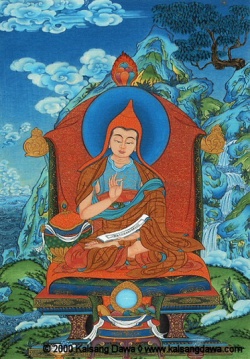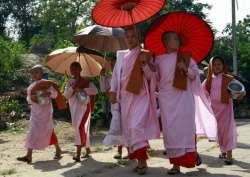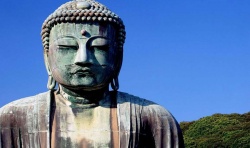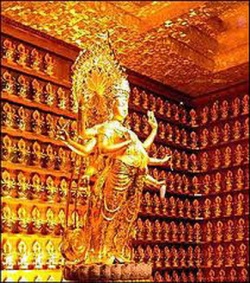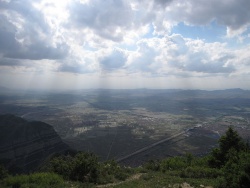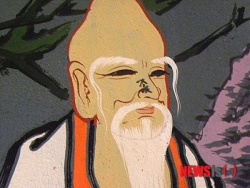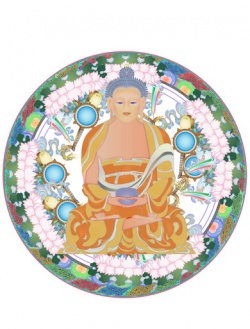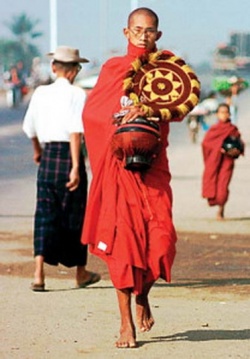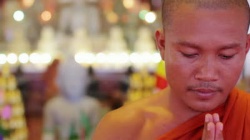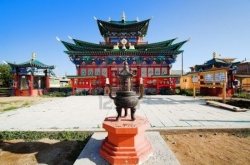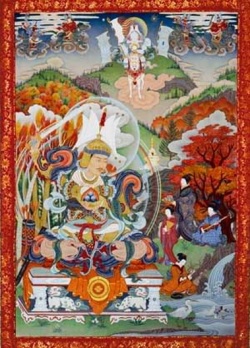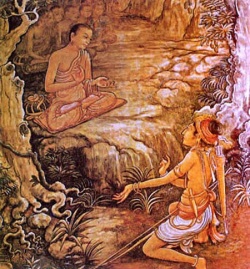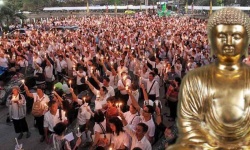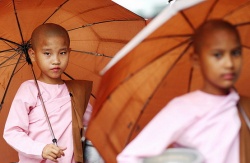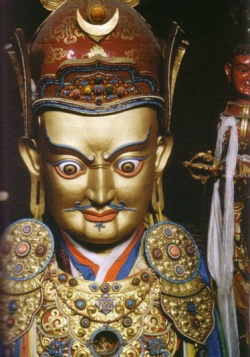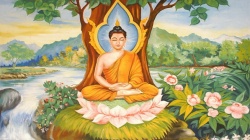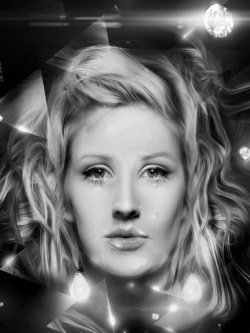Difference between revisions of "THE SHADOW OF THE DALAI LAMA: SEXUALITY, MAGIC AND POLITICS IN TIBETAN BUDDHISM; The Tantric Female Sacrifice"
(Created page with "Until now we have only examined the tantric scheme very broadly and abstractly. But we now wish to show concretely how the “transformation of erotic love into power” is ca...") |
m (Text replacement - "]]]" to "]])") |
||
| (5 intermediate revisions by 3 users not shown) | |||
| Line 1: | Line 1: | ||
| − | + | <nomobile>{{DisplayImages|781|4164|1338|2995|338|3689|2889|906|137|1947|1531|3199|2570|1927|2878|1480|1073|1575|2823|3072|175|2597|3227|1914|1593|2448|2471|3206|69|3395|3846|2816|3077|1748|3967}}</nomobile> | |
| − | |||
| − | |||
| − | |||
| − | |||
| − | |||
| − | + | Until now we have only examined the [[tantric]] scheme very broadly and abstractly. But we now wish to show concretely how the “[[transformation]] of {{Wiki|erotic}} [[love]] into power” is carried out. We thus return to the starting point, the love-play between [[yogi]] and [[yogini]], [[god]] and [[goddess]], and first examine the various {{Wiki|feminine}} typologies which the [[tantric master]] uses in his [[rituals]]. [[Vajrayana]] distinguishes three types of woman in all: | |
| − | + | The “real woman” ([[karma mudra]]). She is a real [[human]] partner. According to [[tantric]] [[doctrine]] she belongs to the “[[realm of desire]]”. | |
| − | + | The “[[imaginary]] woman” or “[[spirit]] woman” (inana [[mudra]]). She is summonsed by the [[yogi’s]] [[meditative]] [[imagination]] and only [[exists]] there or in his [[fantasy]]. The inana [[mudra]] is placed in the “[[realm]] of [[forms]]”. | |
| − | + | The “inner woman” ([[maha mudra]]). She is the woman internalized via the [[tantric]] praxis, with [[no existence]] {{Wiki|independent}} of the [[yogi]]. She is not even credited with the [[reality]] of an [[imagined]] [[form]], therefore she counts as a figure from the “[[formless realm]]”. | |
| − | + | All three types of woman are termed [[mudra]]. This [[word]] originally meant ‘{{Wiki|seal}}’, ‘stamp’, or ‘[[letter]] of the [[alphabet]]’. It further indicated certain [[magical]] [[hand gestures]] and [[body]] [[postures]], with which the [[yogi]] conducted, controlled and “sealed” the [[divine]] energies. This [[Wikipedia:Semantics|semantic]] richness has led to all manner of speculation. For example, we read that the [[tantric master]] “stamps” the [[phenomena]] of the [[world]] with [[happiness]], and that as his companion helps him do this, she is known as [[mudra]] (‘stamp’). More concretely, the [[Maha Siddha]] [[Naropa]] refers to the fact that a [[tantric]] partner, in contrast to a normal woman, assists the [[guru]] in blocking his ejaculation during the {{Wiki|sexual}} act, and as it were “[[seals]]” this, which is of major importance for the performance of the [[ritual]]. For this [[reason]] she is known as [[mudra]], ‘{{Wiki|seal}}’ ([[Naropa]], 1994, p. 81). But the actual meaning probably lies in the following: in [[Vajrayana]] the {{Wiki|feminine}} itself is “sealed”, that is, spellbound via a [[magic]] act, so that it is available to the [[tantric master]] in its entirety. | |
| − | + | The [[karma mudra]]: the real woman: | |
| − | + | What then are the external criteria which a [[karma mudra]], a real woman, needs to meet in order to serve a [[guru]] as [[wisdom consort]]? The [[Hevajra Tantra]], for example, describes her in the following words: “She is neither too tall, nor too short, neither quite black nor quite white, but dark like a [[lotus]] leaf. Her [[breath]] is sweet, and her {{Wiki|sweat}} has a [[pleasant]] {{Wiki|smell}} like that of musk. Her pudenda gives forth a {{Wiki|scent}} from [[moment]] to [[moment]] like different kinds of [[lotuses]] or like sweet {{Wiki|aloe}} [[wood]]. She is [[calm]] and resolute, [[pleasant]] in {{Wiki|speech}} and altogether delightful” (Snellgrove, 1959, p. 116). At another juncture the same [[tantra]] recommends that the [[guru]] “take a [[consort]] who has a beautiful face, is wide-eyed, is endowed with grace and youth, is dark, courageous, of good [[family]] and originates from the {{Wiki|female}} and {{Wiki|male}} fluids” (Farrow and Menon, 1992, p. 217). [[Gedün Chöpel]], a famous [[tantric]] from the 20th century, draws a {{Wiki|distinction}} between the various regions from which the women come. Girls from [[Kham]] province, for example, have soft flesh, lovers from Dzang are well-versed in the {{Wiki|erotic}} techniques, “[[Kashmiri]] girls” are to be valued for their [[smile]], and so on (Chöpel, 1992, p. 45). | |
| − | + | Sometimes it is also required of the [[karma mudra]] that as well as being attractive she also possess specialized {{Wiki|erotic}} skills. For example, the [[Kalachakra Tantra]] recommends {{Wiki|training}} in the sophisticated [[Indian]] {{Wiki|sexual}} techniques of the [[Kama Sutra]]. In this famous handbook on the intensification of {{Wiki|sexual}} [[lust]], the reader can inform him- or herself about the most [[daring]] positions, the use of {{Wiki|aphrodisiacs}}, the anatomical advantages various women possess, the seduction of young girls, dealings with courtesans, and much more. The sole [[intention]] of the [[Kama Sutra]], however, is to sexualize [[life]] as a whole. In contrast to the [[tantras]] there are no [[religious]] and power-political {{Wiki|intentions}} to be found behind this work. It thus has no intrinsic value for the [[tantric yogi]]. The [[latter]] uses it purely as a source of inspiration, to stimulate his [[desires]] which he then brings under [[conscious]] control. | |
| − | + | Youth is a further requirement which the [[mudra]] has to meet. The [[Maha Siddha]] [[Saraha]] distinguishes five different [[wisdom]] [[consorts]] on the basis of age: the eight-year-old virgin ([[kumari]]); the twelve-year-old salika; the sixteen-year-old [[siddha]], who already bleeds monthly; the twenty-year-old balika, and the twenty-five-year-old bhadrakapalini, who he describes as the “burned fat of [[prajna]]” ([[Wayman]], 1973, p. 196). The “{{Wiki|modern}}” [[tantric]] already mentioned, [[Lama]] [[Gedün Chöpel]], explicitly warns that children can become injured during the {{Wiki|sexual}} act: “Forcingly doing it with a young girl produces severe [[pains]] and wounds her genitalia. ... If it is not the time and if copulating would be [[dangerous]] for her, churn about between her thighs, and it [the {{Wiki|female}} seed] will come out” (Chöpel, 1992, p. 135). In addition he recommends feeding a twelve-year-old [[honey]] and sweets before [[ritual sexual intercourse]] (Chöpel, 1992, p. 177). | |
| − | + | When the [[king]] and later [[Maha Siddha]], [[Dombipa]], one day noticed the beautiful daughter of a traveling singer before his palace, he selected her as his [[wisdom consort]] and bought her from her father for an enormous sum in {{Wiki|gold}}. She was “an innocent virgin, untainted by the sordid [[world]] about her. She was utterly [[charming]], with a fair complexion and classical features. She had all the qualities of a [[padmini]], a [[lotus child]], the rarest and most desirable of all girls” (Dowman, 1985, pp. 53–54). What became of the “[[lotus child]]” after the [[ritual]] is not recorded. | |
| − | + | “In the [[rite]] of ‘virgin-worship’ (kumari-puja)”, writes Benjamin Walker, “a girl is selected and trained for [[initiation]], and innocent of her impending [[fate]] is brought before the [[altar]] and [[worshipped]] in the nude, and then deflowered by a [[guru]] or [[chela]]” (Walker, 1982, p. 72). It was not just the [[Hindu]] [[tantrics]] who practiced [[rituals]] with a [[kumari]], but also the [[Tibetans]], in any case the Grand [[Abbot]] of the [[Sakyapa]] [[Sect]], even though he was [[married]]. | |
| − | + | On a {{Wiki|numerological}} basis twelve- or sixteen-year-old girls are preferred. Only when none can be found does [[Tsongkhapa]] recommend the use of a twenty-year-old. There is also a table of correspondences between the various ages and the [[elements]] and [[senses]]: an 11-year-old represents the [[air]], a 12-year-old [[fire]], a 13-year-old [[water]], a 14-year-old [[earth]], a15-year-old [[sound]], a 16-year-old the [[sense]] of {{Wiki|touch}}, a 17-year-old {{Wiki|taste}}, an 18-year-old shape or [[form]], and a 20-year-old the [[sense of smell]] ([[Naropa]], 1994, p. 189). | |
| − | The | + | The [[rituals]] should not be performed with women older than this, as they absorb the “[[occult]] forces” of the [[guru]]. The dangers associated with older [[mudras]] are a topic discussed at length. A famous [[tantric]] commentator describes 21- to 30-year-olds as “[[goddesses]] of [[wrath]]” and gives them the following names: The Blackest, the Fattest, the [[Greedy]], the Most [[Arrogant]], the Stringent, the Flashing, the Grudging, the {{Wiki|Iron}} Chain, and the Terrible [[Eye]]. 31- to 38-year-olds are considered to be [[manifestations]] of malignant [[spirits]] and 39- to 46-year-olds as “[[unlimited]] [[manifestations]] of the {{Wiki|demons}}”. They are called {{Wiki|Dog}} Snout, Sucking Gob, Jackal Face, [[Tiger]] Gullet, [[Garuda]] Mug, {{Wiki|Owl}} Features, Vulture’s Beak, Pecking [[Crow]] ([[Naropa]], 1994, p. 189). These women, according to the text, shriek and scold, menace and curse. In order to get the [[yogi]] completely off [[balance]], one of these terrible figures calls out to him in the [[Kalachakra Tantra]], “[[Human]] beast, you are to be crushed today”. Then she gnashes her {{Wiki|teeth}} and hisses, “Today I must devour your flesh”, and with trembling {{Wiki|tongue}} she continues, “From your [[body]] I will make the drink of {{Wiki|blood}}” (Grünwedel, [[Kalacakra]] III, p. 191). That some radical [[tantras]] view it as especially {{Wiki|productive}} to copulate with such {{Wiki|female}} “monsters” is a topic to which we shall later return. |
| − | + | How does the [[yogi]] find a real, [[human]] [[mudra]]? Normally, she is delivered by his pupil. This is also true for the [[Kalachakra Tantra]]. “If one gives the [[enlightened teacher]] the [[prajna]] ([[mudra]]) as a [[gift]],” proclaims [[Naropa]], “the [[yoga]] is [[bliss]]” (Grünwedel, 1933, p. 117). If a 12- or 16-year-old girl cannot be found, a 20-year-old will suffice, advises another text, and continues, “One should offer his sister, daughter or wife to the ‘[[guru]]’”, then the more valuable the [[mudra]] is to the pupil, the more she serves as a [[gift]] for his [[master]] ([[Wayman]], 1977, p. 320). | |
| − | + | Further, [[magic]] {{Wiki|spells}} are [[taught]] with which to summons a partner. The [[Hevajra Tantra]] recommends the following [[mantra]]: “Om Hri — may she come into my power — savaha!” (Snellgrove, 1959, p. 54). Once the [[yogi]] has repeated this saying ten thousand times the [[mudra]] will appear before him in flesh and {{Wiki|blood}} and obey his wishes. | |
| − | + | The [[Kalachakra Tantra]] [[urges]] the [[yogi]] to render the [[mudra]] pliant with [[intoxicating]] [[liquor]]: “Wine is [[essential]] for the [[wisdom consort]] ([[prajna]]). ... Any [[mudra]] at all, even those who are still not willing, can be procured with drink” (Grünwedel, [[Kalacakra]] III, p. 147). It is only a small step from this to the use of direct force. There are also texts, which advise “that if a woman refuses [[sexual union]] she must be forced to do so” ([[Bhattacharyya]], 1982, p. 125). | |
| − | + | Whether or not a [[karma mudra]] needs special {{Wiki|training}} before the [[ritual]] is something which receives varying answers in the texts and commentaries. In general, she should be familiar with the [[tantric]] [[doctrine]]. [[Tsongkhapa]] advises that she take and keep a [[vow]] of [[silence]]. He expressly warns against intercourse with unworthy partners: “If a woman lacks ... superlative qualities, that is an {{Wiki|inferior}} [[lotus]]. Do not stay with that one, because she is full of negative qualities. Make an [[offering]] and show some [[respect]], but don’t practice (with her)” (quoted in Shaw, 1994, p. 169). In the [[Hevajra Tantra]] a one-month preparation time is required, then “the girl [is] freed of all false [[ideas]] and received as though she were a boon” (Snellgrove, 1987, vol. 1, p. 261). | |
| − | + | But what happens to the “boon” once the [[ritual]] is over? “The [[karma mudra]] ... has a purely {{Wiki|pragmatic}} and instrumental significance and is superfluous at the finish” writes the {{Wiki|Italian}} [[Tibetologist]] [[Raniero Gnoli]] in the introduction to a [[Kalachakra]] commentary ([[Naropa]], 1994, p. 82). After the {{Wiki|sexual}} act she is “of no more use to the [[tantrik]] than husk of a shelled peanut”, says Benjamin Walker (Walker, 1982, pp. 72–73). She has done her [[duty]], transferred her {{Wiki|feminine}} [[energy]] to the [[yogi]], and now succumbs to the disdain which [[Buddhism]] holds for all “normal” women as [[symbols]] of the “supreme [[illusion]]” ([[maha maya]]). There is no mention of an [[initiation]] of the {{Wiki|female}} partner in the codified [[Buddhist tantra]] texts. | |
| − | + | The [[karma mudra]] and the [[West]]: | |
| − | + | Since the general public demands that a [[Tibetan]] [[lama]] lead the [[life]] of a [[celibate monk]], he must keep his {{Wiki|sexual}} practices secret. For this [[reason]], documents about and [[verbal]] accounts of clerical {{Wiki|erotic}} [[love]] are extremely rare. It is true that the [[sexual magic]] [[rites]] are freely and openly discussed in the [[tantra]] texts, but who does what with whom and where are all “top secret”. Only the immediate followers are informed, the English author June Campbell reports. | |
| − | + | And she has the authority to make such a claim. Campbell had been working for many years as [[translator]] and personal assistant for the [[highest]] ranking [[Kagyüpa]] [[guru]], [[His Holiness]] [[Kalu Rinpoche]] (1905–1989), when the old man (he was then approaching his eighties) one day asked her to become his [[mudra]]. She was completely surprised by this request and could not begin to [[imagine]] such a thing, but then, she reluctantly submitted to the wishes of her [[master]]. As she eventually managed to escape the [[tantric]] [[magic circle]], the previously uninformed public is indebted to her for a number of competent commentaries upon the {{Wiki|sexual}} cabinet {{Wiki|politics}} of {{Wiki|modern}} [[Lamaism]] and the {{Wiki|psychology}} of the [[karma mudra]]. | |
| − | + | What then, according to Campbell, are the [[reasons]] which motivate [[Western]] women to enter into a [[tantric]] relationship, and then afterwards keep their [[experiences]] with the [[masters]] to themselves? First of all, their great [[respect]] and deep reverence for the [[lama]], who as a “[[living Buddha]]” begins and [[ritually]] conducts the liaison. Then, the [[karma mudra]], even when she is not publicly [[acknowledged]], enjoys a high {{Wiki|status}} within the small circle of the informed and, temporarily, the rank of a [[dakini]], i.e., a [[tantric]] [[goddess]]. Her intimate relationship with a “[[holy man]]” further gives her the [[feeling]] that she is herself {{Wiki|holy}}, or at least the opportunity to collect [[good karma]] for herself. | |
| − | + | Of course, the [[mudra]] must [[swear]] a strict [[vow]] of [[absolute]] [[silence]] regarding her relations with the [[tantric master]]. Should she break it, then according to the [[tantric]] penal code she may expect major difficulties, [[insanity]], [[death]] and on top of this millennia of hellish torments. In order to intimidate her, [[Kalu Rinpoche]] is alleged to have told his [[mudra]], June Campbell, that in an earlier [[life]] he killed a woman with a [[mantra]] because she disobeyed him and gossiped about intimacies. “The imposition of secrecy ... in the [[Tibetan]] system”, Campbell writes, “when it occurred solely as a means to {{Wiki|protect}} {{Wiki|status}} , and where it was reinforced by threats, was a powerful weapon in keeping women from achieving any kind of [[integrity]] in themselves. ... So whilst the [[lineage]] system [the [[gurus]]’ chain of [[initiation]]) viewed these [{{Wiki|sexual}}] [[activities]] as promoting the [[enlightenment state]] of the [[lineage holders]], the [[fate]] of one of the two main protagonists, the [[female consort]], remained unrecognized, unspoken and unnamed” (June Campbell, 1996, p. 103). June Campbell also first risked {{Wiki|speaking}} openly about her [[experiences]], which she found repressive and degrading, after [[Kalu Rinpoche]] had [[died]]. | |
| − | + | In her [[book]], this author laments not just the subsequent namelessness of and [[disregard]] for the [[karma mudra]] despite the [[guru]] praising her as a “[[goddess]]” for as long as the [[ritual]] lasted, but also discusses the traumatic [[state]] of “used up” women, who, once their [[master]] has “drunk” their gynergy, are traded in for a “fresh” [[mudra]]. She also makes reference to the naiveté of [[Western]] husbands, who send their spouses to a [[guru]] in good [[faith]], so that they can complete their [[spiritual development]]. (June Campbell, 1996, p. 107). During her relationship with [[Kalu Rinpoche]] he was also practicing with another woman who was not yet twenty years old. The girl [[died]] suddenly, of a [[heart]] attack it was said. We will return to this [[death]], which fits the [[logic]] of the [[tantric]] pattern, at a later stage. The {{Wiki|fears}} which such events [[awakened]] in her, reports Campbell, completely cut her off from the outside [[world]] and left her totally delivered up to the {{Wiki|domination}} of her [[guru]]. | |
| − | + | This {{Wiki|masculine}} [[arrogance]] becomes particularly obvious in a statement by the young [[lama]], [[Dzongsar Khyentse Rinpoche]], who announced the following in response to Campbell’s commotion stirring [[book]]: “If [[Western]] women begin {{Wiki|sexual}} relationships with [[Tibetan]] [[lamas]], then the consequence for a number of them is [[frustration]], because their culturally [[conditioned]] expectations are not met. If they {{Wiki|hope}} to find an agreeable and {{Wiki|equal}} lover in a [[Rinpoche]], they could not be making a bigger mistake. Certain [[Rinpoches]], who are revered as great [[teachers]], would literally make the worst partners of all — seen from the point of view of the [[ego]]. If one approaches such a [[great master]] expecting to be [[acknowledged]], and wishing for a relationship in which one shares, satisfies one another, etc., then one is making a bad choice — not just from the ego’s point of view, but also in a completely normal, [[worldly]] [[sense]]. They probably won’t bring them [[flowers]] or invite them to candlelight dinners” (Esotera, 12/97, p. 45; retranslation). It speaks for such a quotation that it is honest, since it quite plainly acknowledges the [[spiritual]] {{Wiki|inferiority}} of women (who represent the [[ego]], [[desire]] and banality) when confronted with the superhuman [[spiritual]] authority of the {{Wiki|male}} [[gurus]]. The [[tantric master]] [[Khyentse Rinpoche]] [[knows]] exactly what he is talking about, when he continues with the following sentence: “Whilst in the [[West]] one [[understands]] equality to mean that two aspects find a common denominator, in [[Vajrayana Buddhism]] equality lies completely outside of twoness or [[duality]]. Where [[duality]] is retained, there can be no equality” (Esotera, 12/97, p. 46; retranslation). That is, in other words: the woman as {{Wiki|equal}} and autonomous partner must be eliminated and has to surrender her energies to the [[master’s]] completion (beyond [[duality]]). | |
| − | + | The “{{Wiki|sexual}} abuse” of [[Western]] women by [[Tibetan]] [[lamas]] has meanwhile become something of a [[constant]] topic in the [[Buddhist]] scene and has also triggered heated [[discussion]] on the Internet. There we can read the following from an author called Mary Finnigan: “In some instances a {{Wiki|male}} [[teacher]] would be having {{Wiki|sex}} with several women students over a period of time. Each would be sworn to secrecy and each would be led to believe that she was the only [[consort]]. Then inevitably the secret came out and the effect of this on the particular [[dharma]] group was devastating” (Finnigan, Newsgroup 5). Finnigan answers the question of how the [[Tibetans]] behaved in such cases as follows: “My [[understanding]] is that [[Tibetan]] women regarded it as an [[honor]] and a [[duty]] to [[sleep]] with a [[lama]] if requested. I do not think the {{Wiki|concept}} of {{Wiki|sexual}} abuse was known to them until they became refugees (Finnigan, Newsgroup 5). | |
| − | + | Even the official office of the [[Fourteenth Dalai Lama]] has had to respond to the increasingly common allegations: “What some of these students have [[experienced]] is terrible and most unfortunate”, announced Tenzin Tethon, a secretary to [[His Holiness]], and admitted that for a number of years there had already been reports of such incidents (Lattin, Newsgroup 2). Naturally, Tenzin Tethon made no mention of the fact that the {{Wiki|sexual}} exploitation of women for [[spiritual]] purposes [[forms]] the [[heart]] of the [[tantric]] {{Wiki|mystery}}. | |
| − | The | + | But there are more and more examples where women are beginning to defend themselves. Thus, in 1992 the well-known bestseller author and commentator on the [[Tibetan Book of the Dead]], [[Sogyal Rinpoche]], had to face the Supreme Court of {{Wiki|Santa Cruz}}, alleged to have “used his position as an interpreter of [[Tibetan Buddhism]] to take {{Wiki|sexual}} and other advantage of {{Wiki|female}} students over a period of many years” ([[Tricycle]] 1996, vol. 5 no. 4, p. 87). The plaintiff was seeking 10 million dollars. It was claimed [[Sogyal Rinpoche]] had assured his numerous partners that it would be extremely salutary and [[spiritually]] rewarding to [[sleep]] with him. Another [[mudra]], Victoria Barlow from {{Wiki|New York City}}, described in an interview with Free Press how she, at the age of 21, was summoned into Sogyal [[Rinpoche’s]] room during a [[meditative]] [[retreats]]: “I went to an apartment to see a highly esteemed [[lama]] and discuss [[religion]]. He opened the door without a shirt on and with a beer in his hand”. When they were sitting on the sofa, the [[Tibetan]] “lunged at me with sloppy kisses and groping. I [[thought]] [then] I should take it as the deepest compliment that he was [[interested]] and basically surrender to him”. Today, Barlow says that she is “disgusted by the way the [[Tibetans]] have manipulated the reverence westerners have for the [[Buddhist path]]” (Lattin, Newsgroup 2). The case mentioned above was, however, settled out of court; the result, according to Sogyal’s followers, of their [[master’s]] deep [[meditation]]. |
| − | In | + | It would normally be correct to dismiss such “{{Wiki|sex}} stories” as superfluous {{Wiki|gossip}} and [[disregard]] them. In the [[occult]] [[logic]] of [[Vajrayana]], however, they need to be seen as strategically placed [[ritual practices]] designed to bring the [[guru]] power and influence. Perhaps they additionally have something to do with the [[Buddhist]] conquest of the [[West]], which is [[symbolized]] by various [[mudras]]. Such conjectures may [[sound]] rather bizarre, but in [[Tantrism]] we are confronted with a different [[logic]] to that to which we are accustomed. Here, {{Wiki|sexual}} events are not uncommonly globalized and capable of influencing all of humankind. We shall return to this point. |
| − | Highest mistress of the world! | + | But at least such examples show that [[Tibet’s]] “[[celibate]]” [[monks]] “practice” with real women — a fact about which the [[Tibetan]] {{Wiki|clergy}} [[including]] the [[Fourteenth Dalai Lama]] have deceived the [[West]] until now. Because more and more “[[wisdom]] [[consorts]]” are breaking their oath to secrecy, it is only now that the [[conditions]] are being created for a public [[discussion]] of the [[tantric rituals]] as such. The [[criticism]] to date has not gone beyond a moral-feminist [[discourse]] and in no case known to us (with the exception of some of June Campbell’s statements) has it extended to the [[occult]] exploitative {{Wiki|mechanism}} of [[Vajrayana]]. |
| + | |||
| + | On the other hand, the fact that the {{Wiki|sexual}} needs of the [[lamas]] can no longer be covered up, has, in a type of advance strategy, led to a situation in which their “[[spiritual]]” work with [[karma]] [[mudras]] is presentable as something to be taken for granted, and which is not inherently shocking. “Many [[Rinpoches]]”, one Christopher Fynn has written on the Internet, “[[including]] Jattral [[Rinpoche]], [[Dzongsar Khyentse]], [[Dilgo Khyentse]] and Ongen [[Tulku]] have [[consorts]] — which everyone knew about” (Fynn, Newsgroup 4). | ||
| + | |||
| + | And the [[Dalai Lama]], himself the [[Highest]] [[Master]] of the [[sexual magic]] [[rites]], raises the [[moral]] finger: “In recent years, [[teachers]] from {{Wiki|Asia}} and the [[West]] have been involved in scandals about {{Wiki|sexual}} misbehavior towards {{Wiki|male}} and {{Wiki|female}} pupils, the abuse of [[alcohol]] and [[drugs]], and the {{Wiki|misuse}} of [[money]] and power. This {{Wiki|behavior}} has [[caused]] great damage to the [[Buddhist community]] and {{Wiki|individual}} [[people]]. Pupils of both sexes should be encouraged to confront [[teachers]] with {{Wiki|unethical}} aspects of their {{Wiki|behavior}} in an appropriate manner” (Esotera, 12/97, p. 45; retranslation). What should be made of such requests by [[His Holiness]], which are also [[silent]] about the sexist mechanisms of [[Tantrism]] is a topic which we explore in detail in the second part of our study. | ||
| + | |||
| + | Following these up-to-date “revelations” about [[Western]] [[karma]] [[mudras]], let us return to our presentation of the [[tantric]] scenario as described in the [[traditional]] texts. | ||
| + | |||
| + | The inana [[mudra]]: the woman of [[imagination]] | ||
| + | |||
| + | In contrast to the real [[karma mudra]], the inana [[mudra]] is a purely [[spiritual]] figure, who appears as a [[goddess]], the [[wisdom consort]] of various [[Buddhas]], or as a “[[dakini]]”. She is the product of the [[imagination]]. But we must keep in [[mind]] that the inana [[mudra]] may never be a random [[fantasy]] of the [[guru]], rather, her external [[appearance]], the {{Wiki|color}} of her [[hair]], her clothing, her jewelry and the [[symbols]] which surround her, are all codified. Thus, in his [[imagination]] the [[tantric]] copies an image which is already recorded in the [[Buddhist pantheon]]. In this regard the {{Wiki|cult}} of inana [[mudra]] {{Wiki|worship}} has much in common with [[Christian]] [[mysticism]] surrounding [[Sophia]] and Mary and has therefore often been compared with, for example, the mater gloriosa at the end of Goethe’s Faust, where the reformed {{Wiki|alchemist}} rapturously {{Wiki|cries}}: | ||
| + | |||
| + | [[Highest]] mistress of the [[world]]! | ||
Let me in the azure | Let me in the azure | ||
| − | Tent of Heaven, in light unfurled | + | Tent of [[Heaven]], in {{Wiki|light}} unfurled |
| − | Hear thy Mystery measure! | + | Hear thy {{Wiki|Mystery}} measure! |
| − | Justify sweet thoughts that move | + | Justify sweet [[thoughts]] that move |
Breast of man to meet thee! | Breast of man to meet thee! | ||
| − | And with holy bliss of love | + | And with {{Wiki|holy}} [[bliss]] of [[love]] |
Bear him up to greet thee! | Bear him up to greet thee! | ||
(Faust II, 11997–12004) | (Faust II, 11997–12004) | ||
| − | Here, “the German poet Goethe … unsuspectingly expresses the Buddhist awareness of the Jñānamudrā [inana mudra]” notes Herbert Guenther, who has attempted in a number of writings to interpret the tantras from the viewpoint of a European philosopher (Guenther, 1976, p. 74). | + | Here, “the [[German]] poet [[Goethe]] … unsuspectingly expresses the [[Buddhist]] [[awareness]] of the Jñānamudrā [inana [[mudra]])” notes {{Wiki|Herbert Guenther}}, who has attempted in a number of writings to interpret the [[tantras]] from the viewpoint of a {{Wiki|European}} [[philosopher]] ([[Guenther]], 1976, p. 74). |
| − | It should however be noted that such Western sublimations of the feminine only correspond to a degree with the imaginings of Indian and Tibetan tantrics. There, it is not just noble and ethereal virgins who are conjured up in the | + | It should however be noted that such [[Western]] sublimations of the {{Wiki|feminine}} only correspond to a [[degree]] with the imaginings of [[Indian]] and [[Tibetan]] [[tantrics]]. There, it is not just [[noble]] and [[ethereal]] virgins who are conjured up in the [[yogis]]’ [[imaginations]], but also [[sensuous]] “[[dakinis]]” trembling with [[lust]], who not uncommonly appear as figures of [[horror]], [[goddesses]] with [[bowls]] made of skulls and cleavers in their hands. |
| − | But whatever sort of a woman the adept imagines, in all events he will unite sexually with this spiritual being during the ritual. The white and refined “Sophias” from the realm of the imagination are not exempted from the ritual sexual act. “Among the last phases of the tantrik’s progress”, Benjamin Walker tells us, “is sexual union on the astral plane, when he invokes elemental spirits, fiendesses and the spirits of the dead, and has intercourse with them” (Walker, 1982, p. 74). | + | But whatever sort of a woman the {{Wiki|adept}} imagines, in all events he will unite sexually with this [[spiritual being]] during the [[ritual]]. The white and refined “Sophias” from the [[realm]] of the [[imagination]] are not exempted from the [[ritual]] {{Wiki|sexual}} act. “Among the last phases of the tantrik’s progress”, Benjamin Walker tells us, “is [[sexual union]] on the [[astral plane]], when he invokes [[elemental spirits]], fiendesses and the [[spirits of the dead]], and has intercourse with them” (Walker, 1982, p. 74). |
| − | Since the yogi produces his wisdom companion through the imaginative power of his spirit, he can rightly consider himself her spiritual father. The inana mudra is composed of the substance of his own thoughts. She thus does not consist of matter, but — and this is very important — she nonetheless appears outside of her imagination-father and initially encounters him as an autonomous subject. He thus experiences her as a being who admittedly has him alone to thank for her being, but who nevertheless has a life of her own, like a child, separated from its mother once it is born. | + | Since the [[yogi]] produces his [[wisdom]] companion through the imaginative power of his [[spirit]], he can rightly consider himself her [[spiritual]] father. The inana [[mudra]] is composed of the [[substance]] of his [[own]] [[thoughts]]. She thus does not consist of {{Wiki|matter}}, but — and this is very important — she nonetheless appears outside of her imagination-father and initially encounters him as an autonomous [[subject]]. He thus [[experiences]] her as a being who admittedly has him alone to thank for her being, but who nevertheless has a [[life]] of her [[own]], like a child, separated from its mother once it is born. |
| − | In all, the tantras distinguish two “types of | + | In all, the [[tantras]] distinguish two “types of [[birth]]” for [[imagined]] {{Wiki|female}} partners: firstly, the “women produced by {{Wiki|spells}}”; secondly, the “field-born [[yoginis]]”. In both cases we are dealing with so-called “{{Wiki|feminine}} [[energy]] fields” or {{Wiki|feminine}} {{Wiki|archetypes}} which the [[tantric master]] can through his imaginative [[powers]] render [[visible]] for him as “[[illusory]] [[bodies]]”. This usually takes place via a deep [[meditation]] in which the [[yogi]] [[visualizes]] the inana [[mudra]] with his “[[spiritual]] [[eye]]” ([[Wayman]], 1973, pp. 193–195). |
| − | As a master of unbounded imagination, the yogi is seldom content with a single inana mudra, and instead creates several female beings from out of his spirit, either one after another or simultaneously. The Kalachakra Tantra describes how the imagined | + | As a [[master]] of unbounded [[imagination]], the [[yogi]] is seldom content with a single inana [[mudra]], and instead creates several {{Wiki|female}} [[beings]] from out of his [[spirit]], either one after another or simultaneously. The [[Kalachakra Tantra]] describes how the [[imagined]] “[[goddesses]]” spring from various parts of his [[body]], from out of his head, his {{Wiki|forehead}}, his neck, his [[heart]] and his {{Wiki|navel}}. He can conjure up the most diverse entities in the [[form]] of women, such as [[elements]], {{Wiki|planets}}, energies, forces and [[emotions]] — [[compassion]] for example: “as the [[incarnation]] of this arises in his [[heart]] a golden glowing woman wearing a white robe. ... Then this woman steps ... out of his [[heart]], spreads herself out to the [[heaven]] of the [[gods]] like a cloud and lets down a [[rain]] of [[nourishment]] as an antidote for all [[bodily]] [[suffering]]” (Gäng, 1988, p. 44). |
| − | Karma mudra vs. inana mudra: | + | [[Karma mudra]] vs. inana [[mudra]]: |
| − | In the tantric literature we find an endless discussion about whether the magical sexual act with a karma mudra of flesh and blood must be valued more highly than that with an imagined inana mudra. For example, Herbert Guenther devotes a number of pages to this debate in his existentialist study of Vajrayana. Although he also reports in detail about the “pro-woman” intentions of the tantras, he comes to the surprising conclusion that we have in the karma mudra a woman “who yields pleasure containing the seed of | + | In the [[tantric]] {{Wiki|literature}} we find an [[endless]] [[discussion]] about whether the [[magical]] {{Wiki|sexual}} act with a [[karma mudra]] of flesh and {{Wiki|blood}} must be valued more highly than that with an [[imagined]] inana [[mudra]]. For example, {{Wiki|Herbert Guenther}} devotes a number of pages to this [[debate]] in his [[Wikipedia:existentialism|existentialist]] study of [[Vajrayana]]. Although he also reports in detail about the “pro-woman” {{Wiki|intentions}} of the [[tantras]], he comes to the surprising conclusion that we have in the [[karma mudra]] a woman “who yields [[pleasure]] containing the seed of [[frustration]]”, whilst the inana [[mudra]] is “a woman who yields a purer, though unstable, [[pleasure]]” ([[Guenther]], 1976, p. 57). |
| − | As a product of the PURE SPIRIT, he classes the inana mudra above a living woman. She “is a creation of one’s own mind. She is of the nature of the Great Mother or other goddesses and comprises all that has been previously | + | As a product of the PURE SPIRIT, he classes the inana [[mudra]] above a living woman. She “is a creation of one’s [[own mind]]. She is of the [[nature]] of the Great Mother or other [[goddesses]] and comprises all that has been previously [[experienced]]” ([[Guenther]], 1976, p. 72, quoting [[Naropa]]). But she too finally goes the way of all [[life]] and “therefore also, even [[love]], Jñānamudrā [inana [[mudra]]), gives us merely a fleeting [[sense]] of [[bliss]], although this [[feeling]] is of a higher, and hence more positive, order than the Karmamūdra ([[karma mudra]]) who makes us ‘[[sad]]’…” ([[Guenther]], 1976, p. 75). |
| − | On the other hand there are very weighty arguments for the greater importance of a real woman (karma mudra) in the tantric rite of initiation. Then the purpose of the ritual with her is the final transcending of the real external world of appearance (maya) and the creation of a universe which functions solely according to the will and imagination of the tantric master. His first task is therefore to recognize the illusory character of reality as a whole. This is naturally represented more graphically, tangibly, and factually by a woman of flesh and blood than by a fictive construction of the own spirit, which the inana mudra is. She appears from the outset as the product of an illusion. | + | On the other hand there are very weighty arguments for the greater importance of a real woman ([[karma mudra]]) in the [[tantric]] [[rite]] of [[initiation]]. Then the {{Wiki|purpose}} of the [[ritual]] with her is the final transcending of the real [[external world]] of [[appearance]] ([[maya]]) and the creation of a [[universe]] which functions solely according to the will and [[imagination]] of the [[tantric master]]. His first task is therefore to [[recognize]] the [[illusory]] [[character]] of [[reality]] as a whole. This is naturally represented more graphically, tangibly, and factually by a woman of flesh and {{Wiki|blood}} than by a fictive construction of the [[own]] [[spirit]], which the inana [[mudra]] is. She appears from the outset as the product of an [[illusion]]. |
| − | A karma mudra thus presents an exceptionally difficult challenge to the spiritual abilities of the adept, since the real human woman must also be recognized as an illusion (maya)! This means, in the final instance, nothing less than that the yogi no longer grants the entire physical world, which in Indian tradition concentrates itself in the form of a woman, an independent existence, and that as a consequence he recognizes matter as a conceit of his own consciousness. He thereby frees himself from all restrictions imposed by the laws of nature. Such a radical dissolution of reality is believed to accelerate several times the initiation process which otherwise takes numerous incarnations. | + | A [[karma mudra]] thus presents an exceptionally difficult challenge to the [[spiritual]] {{Wiki|abilities}} of the {{Wiki|adept}}, since the real [[human]] woman must also be [[recognized]] as an [[illusion]] ([[maya]])! This means, in the final instance, nothing less than that the [[yogi]] no longer grants the entire [[physical world]], which in [[Indian]] [[tradition]] [[concentrates]] itself in the [[form]] of a woman, an {{Wiki|independent}} [[existence]], and that as a consequence he [[recognizes]] {{Wiki|matter}} as a [[conceit]] of his [[own]] [[consciousness]]. He thereby frees himself from all restrictions imposed by the laws of [[nature]]. Such a radical dissolution of [[reality]] is believed to accelerate several times the [[initiation]] process which otherwise takes numerous [[incarnations]]. |
| − | Especially if | + | Especially if “[[enlightenment]]” and [[liberation]] from the constraints of [[reality]] is to be achieved in a single [[lifetime]], it is necessary in the opinion of many [[tantra]] commentators to practice with a [[human]] [[mudra]]. In the [[Cakrasamvara Tantra]] we read for example, that “the secret [[path]] without a [[consort]] will not grant [[perfection]] to [[beings]]” (quoted by Shaw, 1994, p. 142). [[Tsongkhapa]], founder of the [[Tibetan]] [[Gelugpa sect]] is of the same opinion: “A {{Wiki|female}} companion is the basis of the [[accomplishment]] of [[liberation]]” (quoted by Shaw, 1994, p. 146). [[Imagined]] women are only recommendable for less qualified {{Wiki|individuals}}, or may serve at the beginning of the [[ritual]] [[path]] as a preliminary exercise, reports [[Miranda Shaw]], who makes reference to {{Wiki|modern}} [[Gelugpa]] [[Masters]] like [[Lama Yeshe]], [[Geshe Kelsang Gyatso]] and [[Geshe]] Dhargyey (Shaw, 1994, pp. 146, 244, notes 26, 27, 29). |
| − | A further reason for the use of a karma mudra can be seen in the fact that for his magical transformations the yogi needs a secretion which the woman expresses during the sexual act and which is referred to as | + | A further [[reason]] for the use of a [[karma mudra]] can be seen in the fact that for his [[magical]] transformations the [[yogi]] needs a secretion which the woman expresses during the {{Wiki|sexual}} act and which is referred to as “{{Wiki|female}} seed” in the texts. It is considered a [[bodily]] [[concentrate]] of gynergy. This coveted vaginal fluid will later be the [[subject]] of a detailed [[discussion]]. |
| − | The maha mudra: the inner woman: | + | The [[maha mudra]]: the inner woman: |
| − | During the tantric ritual the karma mudra must therefore be recognized by the yogi as an illusion. This is of course also true of the inana mudra, since the tantric master as an autonomous being has to transcend both forms of the feminine, the real and the imagined. We have already learned from Herbert Guenther that the | + | During the [[tantric ritual]] the [[karma mudra]] must therefore be [[recognized]] by the [[yogi]] as an [[illusion]]. This is of course also true of the inana [[mudra]], since the [[tantric master]] as an autonomous being has to transcend both [[forms]] of the {{Wiki|feminine}}, the real and the [[imagined]]. We have already learned from {{Wiki|Herbert Guenther}} that the “[[spirit]] woman” is also of fleeting [[character]] and prone to transitoriness. The [[yogi]] may not attribute her with an “[[inherent existence]]”. At the beginning of every [[tantric ritual]] both [[mudras]] still appear outside of him; the [[karma mudra]] before his “real” [[eyes]], the inana [[mudra]] before his “[[spiritual]]” [[eyes]]. |
| − | But does this illusory character of the two types of woman mean that they are dissolved into nothing by the tantric master? As far as their external and autonomous existence is concerned, this is indeed the yogi’s conception. He does not accord even the real woman any further inherent existence. When, after the tantric ritual in which she is elevated to a goddess, she before all eyes returns home in visible, physical form, in the eyes of the guru she no longer exists as an independent being, but merely as the product of his imagination, as a conceptual image — even when a normal person perceives the girl as a being of flesh and blood. | + | But does this [[illusory]] [[character]] of the two types of woman mean that they are dissolved into nothing by the [[tantric master]]? As far as their external and autonomous [[existence]] is concerned, this is indeed the [[yogi’s]] {{Wiki|conception}}. He does not accord even the real woman any further [[inherent existence]]. When, after the [[tantric ritual]] in which she is elevated to a [[goddess]], she before all [[eyes]] returns home in [[visible]], [[physical form]], in the [[eyes]] of the [[guru]] she no longer [[exists]] as an {{Wiki|independent}} being, but merely as the product of his [[imagination]], as a {{Wiki|conceptual}} image — even when a normal [[person]] [[perceives]] the girl as a being of flesh and {{Wiki|blood}}. |
| − | But although her autonomous feminine existence has been dissolved, her feminine essence (gynergy) has not been lost. Via an act of sexual magic the yogi has appropriated this and with it achieved the power of an androgyne. He destroys, so to speak, the exterior feminine in order to internalize it and produce an “inner woman” as a part of himself. “He absorbs the Mother of the Universe into himself”, as it is described in the Kalachakra Tantra (Grünwedel, Kalacakra IV, p. 32). At a later stage we will describe in detail the subtle techniques with which he performs this absorption. Here we simply list some of the properties of the “inner woman”, the so-called maha mudra (“great” mudra). The boundary with the inana mudra is not fixed, after all the maha mudra is also a product of the imagination. Both types of woman thus have no physical body, and instead transcend “the atomic structure and consist of a purely spiritual | + | But although her autonomous {{Wiki|feminine}} [[existence]] has been dissolved, her {{Wiki|feminine}} [[essence]] (gynergy) has not been lost. Via an act of [[sexual magic]] the [[yogi]] has appropriated this and with it achieved the power of an [[androgyne]]. He destroys, so to speak, the exterior {{Wiki|feminine}} in order to internalize it and produce an “inner woman” as a part of himself. “He absorbs the [[Mother of the Universe]] into himself”, as it is described in the [[Kalachakra Tantra]] (Grünwedel, [[Kalacakra]] IV, p. 32). At a later stage we will describe in detail the {{Wiki|subtle}} techniques with which he performs this [[absorption]]. Here we simply list some of the properties of the “inner woman”, the so-called [[maha mudra]] (“great” [[mudra]]). The boundary with the inana [[mudra]] is not fixed, after all the [[maha mudra]] is also a product of the [[imagination]]. Both types of woman thus have no [[physical body]], and instead transcend “the [[atomic]] {{Wiki|structure}} and consist of a purely [[spiritual]] [[substance]]” ([[Naropa]], 1994, p. 82). But the inana [[mudra]] still [[exists]] outside of the [[tantric master]], the “inner woman”, however, as her [[name]] indicates, can no longer be {{Wiki|distinguished}} from him and has become a part of his [[self]]. In general, the [[maha mudra]] is said to reside in the region of the {{Wiki|navel}}. There she dances and acts as an {{Wiki|oracle}} as the {{Wiki|Greek}} [[goddess]] Metis once did in the belly of {{Wiki|Zeus}}. She is the “in-born” and produces the “in-born [[joy]] of the [[body]], the in-born [[joy]] of [[language]], the in-born [[joy]] of the [[spirit]] and the in-born [[joy]] of [[consciousness]]” ([[Naropa]], 1994, p. 204). |
| − | The male tantric master now has the power to assume the female form of the goddess (who is of course an aspect of his own mystical body), that is, he can appear in the figure of a woman. Indeed, he even has the magical ability to divide himself into two gendered beings, a female and a male deity. He is further able to multiply himself into several maha mudras. In the Guhyasamaja Tantra, with the help of magical conjurations he fills an entire palace with female figures, themselves all particles of his subtle body. | + | The {{Wiki|male}} [[tantric master]] now has the power to assume the {{Wiki|female}} [[form]] of the [[goddess]] (who is of course an aspect of his [[own]] [[mystical]] [[body]]), that is, he can appear in the figure of a woman. Indeed, he even has the [[magical]] ability to divide himself into two gendered [[beings]], a {{Wiki|female}} and a {{Wiki|male}} [[deity]]. He is further able to multiply himself into several [[maha]] [[mudras]]. In the [[Guhyasamaja Tantra]], with the help of [[magical]] conjurations he fills an entire palace with {{Wiki|female}} figures, themselves all {{Wiki|particles}} of his [[subtle body]]. |
| − | Now one might think that for the enlightened yogi the book of sensual pleasures would be closed, since for him there are no more exterior women. But the contrary is the case. His lust is not transformed, but rather made eternal. Thus in his imagination, he is “united day and night [with the maha mudra]. The yogi often says, he would not live without her kiss and embrace” (Dasgupta, 1974, p. 102). He is even able to imaginatively stimulate the sexual organs of the inner woman in order to combine her erotic pleasure with his own (he simultaneously enjoys both), and thus immeasurably intensify it. (Farrow and Menon, 1992, pp. 271, 272, 291). | + | Now one might think that for the [[enlightened]] [[yogi]] the [[book]] of [[sensual pleasures]] would be closed, since for him there are no more exterior women. But the contrary is the case. His [[lust]] is not [[transformed]], but rather made eternal. Thus in his [[imagination]], he is “united day and night [with the [[maha mudra]]). The [[yogi]] often says, he would not live without her kiss and embrace” ([[Dasgupta]], 1974, p. 102). He is even able to imaginatively stimulate the {{Wiki|sexual organs}} of the inner woman in order to combine her {{Wiki|erotic}} [[pleasure]] with his [[own]] (he simultaneously enjoys both), and thus immeasurably intensify it. (Farrow and Menon, 1992, pp. 271, 272, 291). |
| − | Despite this sexual turbulence he retains a strict awareness of the polarity of the primal cosmic forces, it is just that these are now realized within his own person. He is simultaneously masculine and feminine, and has both sexual energies under his absolute control. He incarnates the entire tantric theater. He is director, actor, audience, plot and stage in one individual. | + | Despite this {{Wiki|sexual}} turbulence he retains a strict [[awareness]] of the {{Wiki|polarity}} of the primal [[cosmic]] forces, it is just that these are now [[realized]] within his [[own]] [[person]]. He is simultaneously {{Wiki|masculine}} and {{Wiki|feminine}}, and has both {{Wiki|sexual}} energies under his [[absolute]] control. He [[incarnates]] the entire [[tantric]] theater. He is director, actor, audience, plot and stage in one {{Wiki|individual}}. |
| − | Such agitated games are, however, just one side of the tantric philosophy, on the other is a concept of eternal standstill of being, linked to the image of the maha mudra. She appears as the | + | Such agitated games are, however, just one side of the [[tantric philosophy]], on the other is a {{Wiki|concept}} of eternal standstill of being, linked to the image of the [[maha mudra]]. She appears as the “[[Highest]] Immobile”, who, like a clear, [[magical]] [[mirror]], reflects a {{Wiki|femininity}} turned to {{Wiki|crystal}}. An obedient {{Wiki|femininity}} with no will of her [[own]], who complies with the looks, the orders, the [[desires]] and fantasies of her [[master]]. A {{Wiki|female}} automaton, who wishes for nothing, and blesses the [[yogi]] with her [[divine]] [[knowledge]] and {{Wiki|holy}} [[wisdom]]. |
| − | Whether mobile or unmoving, erotic or spiritualized — the maha mudra is universal. From a tantric viewpoint she incarnates the entire universe. Consequently, whoever has control over his “inner woman” becomes a lord of the universe, a pantocrat. She is a paradox, eternal and indestructible, but nevertheless, like the whole cosmos, without an independent existence. For this reason she is known as a | + | Whether mobile or unmoving, {{Wiki|erotic}} or spiritualized — the [[maha mudra]] is [[universal]]. From a [[tantric]] viewpoint she [[incarnates]] the entire [[universe]]. Consequently, whoever has control over his “inner woman” becomes a lord of the [[universe]], a pantocrat. She is a [[paradox]], eternal and [[indestructible]], but nevertheless, like the whole [[cosmos]], without an {{Wiki|independent}} [[existence]]. For this [[reason]] she is known as a “[[magical]] [[mirror]]” ([[Naropa]], 1994, p. 81). In the final instance, she represents the “[[emptiness]]”. |
| − | In Western discussion about the maha mudra she is glorified by Lama Govinda (Ernst Lothar Hoffmann) as the “Eternal | + | In [[Western]] [[discussion]] about the [[maha mudra]] she is glorified by [[Lama Govinda]] ([[Ernst Lothar Hoffmann]]) as the “Eternal {{Wiki|Feminine}}” which now counts as part of the [[yogi’s]] [[essential]] being. ([[Govinda]], 1991, p. 111). According to [[Govinda]] she fulfills a role comparable to that of the muse, who up until the 19th century whispered inspiration into the [[ears]] of {{Wiki|European}} {{Wiki|artists}}. Muses could also become [[incarnated]] as real women, but in the same manner existed as “inner [[goddesses]]”, known then under the [[name]] of “inspiration”. |
| − | The Buddhist doctrine of the maha mudra has also been compared with Carl Gustav Jung’s concept of anima (Katz 1977). Jung proposed that the human soul of a man is double gendered, it has a masculine and a feminine part, the animus and the anima. In a woman the reverse is true. Her feminine anima corresponds to a masculine animus. With some qualifications, the depth psychologist was convinced that the other-gendered part of the soul could originally be found in the psyche of every person. Jung thus assumes the human soul possesses a primary androgyny, or gynandry, respectively. The goal of an integrated psychology is that the individual recognize his or her other-gendered half and bring the two parts of the soul into harmony. | + | The [[Buddhist doctrine]] of the [[maha mudra]] has also been compared with Carl Gustav Jung’s {{Wiki|concept}} of anima (Katz 1977). {{Wiki|Jung}} proposed that the [[human]] [[soul]] of a man is double gendered, it has a {{Wiki|masculine}} and a {{Wiki|feminine}} part, the animus and the anima. In a woman the reverse is true. Her {{Wiki|feminine}} anima corresponds to a {{Wiki|masculine}} animus. With some qualifications, the depth {{Wiki|psychologist}} was convinced that the other-gendered part of the [[soul]] could originally be found in the [[Wikipedia:Psyche (psychology)|psyche]] of every [[person]]. {{Wiki|Jung}} thus assumes the [[human]] [[soul]] possesses a primary androgyny, or gynandry, respectively. The goal of an integrated {{Wiki|psychology}} is that the {{Wiki|individual}} [[recognize]] his or her other-gendered half and bring the two parts of the [[soul]] into [[harmony]]. |
| − | Even if we attribute the same intentions to Tantrism, an essential difference remains. This is, as all the relevant texts claim, that the feminine side of the yogi is initially found outside himself — whether in the form of a real woman or the figure of an imaginary one — and must first be integrated through sacred sexual practices. If — as in Jung — the anima were to be found in the | + | Even if we attribute the same {{Wiki|intentions}} to [[Tantrism]], an [[essential]] difference remains. This is, as all the relevant texts claim, that the {{Wiki|feminine}} side of the [[yogi]] is initially found outside himself — whether in the [[form]] of a real woman or the figure of an [[imaginary]] one — and must first be integrated through [[sacred]] {{Wiki|sexual}} practices. If — as in {{Wiki|Jung}} — the anima were to be found in the “[[mystic]] [[body]]” of the [[tantric master]] from the start, then he would surely be able to activate his {{Wiki|feminine}} side without needing to use an external [[mudra]]. If he could, then all the higher and [[highest]] [[initiations]] into [[Vajrayana]] would be redundant, since they always describe the “inner woman” as the result of a process which begins with an “exterior woman”. |
| − | It is tempting to conclude that a causal relation exists between both female tantric “partners”, the internal and the external. The tantric master uses a human woman, or at least an inana mudra to create his androgynous body. He destroys her autonomous existence, steals her gynergy, integrates this in the form of an “inner woman” and thus becomes a powerful double-gendered super-being. We can, hypothetically, describe the process as follows: the sacrifice of the exterior woman is the precondition for the establishment of the inner maha mudra. | + | It is tempting to conclude that a causal [[relation]] [[exists]] between both {{Wiki|female}} [[tantric]] “partners”, the internal and the external. The [[tantric master]] uses a [[human]] woman, or at least an inana [[mudra]] to create his [[androgynous]] [[body]]. He destroys her autonomous [[existence]], steals her gynergy, integrates this in the [[form]] of an “inner woman” and thus becomes a powerful double-gendered super-being. We can, hypothetically, describe the process as follows: the [[Wikipedia:sacrifice|sacrifice]] of the exterior woman is the precondition for the establishment of the inner [[maha mudra]]. |
| − | The | + | The “[[tantric]] {{Wiki|female}} [[Wikipedia:sacrifice|sacrifice]]” |
| − | But are we really justified in speaking of a | + | But are we really justified in {{Wiki|speaking}} of a “[[tantric]] {{Wiki|female}} [[Wikipedia:sacrifice|sacrifice]]”? We shall attempt to find an answer to this difficult question. Fundamentally, the [[Buddhist tantric]] distinguishes three types of [[Wikipedia:sacrifice|sacrifice]]: the outer, the inner and the secret. The “outer [[Wikipedia:sacrifice|sacrifice]]” consists of the [[offering]] to a [[divinity]], the [[Buddhas]], or the [[guru]], of [[food]], [[incense]], [[butter lamps]], [[perfume]], and so on. For instance in the so-called “[[mandala]] [[Wikipedia:sacrifice|sacrifice]]” the whole [[universe]] can be presented to the [[teacher]], in the [[form]] of a miniature model, whilst the pupil says the following. “I [[Wikipedia:sacrifice|sacrifice]] all the components of the [[universe]] in their {{Wiki|totality}} to you, O [[noble]], kind, and {{Wiki|holy}} [[lama]]!” (Bleichsteiner, 1937, p. 192) |
| − | In the “inner | + | In the “inner [[Wikipedia:sacrifice|sacrifice]]” the pupil ([[Sadhaka]]) gives his [[guru]], usually in a [[symbolic]] act, his [[five senses]] ([[sight]], hearing, {{Wiki|smell}}, {{Wiki|taste}}, and {{Wiki|touch}}), his [[states of consciousness]], and his [[feelings]], or he offers himself as an {{Wiki|individual}} up to be sacrificed. Whatever the [[master]] demands of him will be done — even if the [[sadhaka]] must cut the flesh from his [[own]] limbs, like the [[tantric]] {{Wiki|adept}} [[Naropa]]. |
| − | Behind the “secret | + | Behind the “secret [[Wikipedia:sacrifice|sacrifice]]” hides, finally, a particular [[ritual]] event which attracts our especial [[interest]], since it is here that the location of the “[[tantric]] {{Wiki|female}} [[Wikipedia:sacrifice|sacrifice]]” is to be suspected. It concerns — as can be read in a {{Wiki|modern}} commentary upon the [[Kalachakra Tantra]] — “the [[spiritual]] [[Wikipedia:sacrifice|sacrifice]] of a [[dakini]] to the [[lama]]” (Henss, 1985, p. 56). Such [[symbolic]] [[sacrifices]] of [[goddesses]] are all but stereotypical of [[tantric]] {{Wiki|ceremonies}}. “The exquisite bejeweled woman ... is [[offered]] to the [[Buddhas]]” (Gäng, 1988, p. 151), as the [[Guhyasamaja Tantra]] puts it. Often eight, sometimes sixteen, occasionally countless “[[wisdom]] girls” are [[offered]] up in “the {{Wiki|holy}} most secret of [[offerings]]” (quoted by Beyer, 1978, p. 162) |
| − | The sacrifice of samsara: | + | The [[Wikipedia:sacrifice|sacrifice]] of [[samsara]]: |
| − | A sacrifice of the feminine need not be first sought in Tantrism, however; rather it may be found in the logic of the entire Buddhist doctrine. Woman per | + | A [[Wikipedia:sacrifice|sacrifice]] of the {{Wiki|feminine}} need not be first sought in [[Tantrism]], however; rather it may be found in the [[logic]] of the entire [[Buddhist doctrine]]. [[Woman]] [[per se]]– as [[Buddha Shakyamuni]] repeatedly emphasized in many of his statements — functions as the first and greatest [[cause]] of [[illusion]] ([[maya]]), but likewise as the force which generates the [[phenomenal world]] ([[samsara]]). It is the fundamental goal of every [[Buddhist]] to overcome this deceptive [[samsara]]. This [[world]] of [[appearances]] [[experienced]] as {{Wiki|feminine}}, presents him with his greatest challenge. “A woman”, Nancy Auer Falk writes, “was the veritable image of becoming and of all the forces of [[blind]] growth and productivity which [[Buddhism]] knew as [[Samsara]]. As such she too was the enemy — not only on a personal level, as an {{Wiki|individual}} source of {{Wiki|temptation}}, but also on a [[cosmic]] level” (Gross, 1993, p. 48). In this misogynist [[logic]], it is only after the [[ritual]] destruction of the {{Wiki|feminine}} that the [[illusory]] [[world]] ([[maya]]) can be surmounted and transcended. |
| − | Is it for this reason that maya (illusion), the mother of the historical Buddha, had to die directly after giving birth? In her early death we can recognize the original event which stands at the beginning of the fundamentally misogynist attitude of all Buddhist schools. Maya both conceived and gave birth to the Sublime One in a supernatural manner. It was not a sexual act but an elephant which, in a dream, occasioned the conception, and Buddha Shakyamuni did not leave his mother’s body through the birth canal, but rather through her hip. But these transfeminine birth myths were not enough for the tellers of legends. Maya as earthly mother had, on the path to enlightenment of a religion which seeks to free humanity from the endless chain of reincarnation, to be proclaimed an | + | Is it for this [[reason]] that [[maya]] ([[illusion]]), the mother of the [[historical Buddha]], had to [[die]] directly after giving [[birth]]? In her early [[death]] we can [[recognize]] the original event which stands at the beginning of the fundamentally misogynist [[attitude]] of all [[Buddhist]] schools. [[Maya]] both [[conceived]] and gave [[birth]] to the [[Sublime One]] in a [[supernatural]] manner. It was not a {{Wiki|sexual}} act but an [[elephant]] which, in a [[dream]], occasioned the {{Wiki|conception}}, and [[Buddha Shakyamuni]] did not leave his mother’s [[body]] through the [[birth]] canal, but rather through her hip. But these transfeminine [[birth]] [[myths]] were not enough for the tellers of {{Wiki|legends}}. [[Maya]] as [[earthly]] mother had, on the [[path to enlightenment]] of a [[religion]] which seeks to free [[humanity]] from the [[endless]] chain of [[reincarnation]], to be proclaimed an “[[illusion]]” ([[maya]]) and destroyed. She receives no higher accolade in the school of [[Buddha]], since the woman — as mother and as lover — is the curse which [[fetters]] us to our [[illusory]] [[existence]]. |
| − | Already in Mahayana Buddhism, the naked corpse of a woman was considered as the most provocative and effective meditation object an initiand could use to free himself from the net of Samsara. Inscribed in the iconography of her body were all the vanities of this world. For this reason, he who sank bowed over a decaying female body could achieve enlightenment in his current life. To increase the intensity of the macabre observation, it was usual in several Indian monastic orders to dismember the corpse. Ears, nose, hands, feet, and breasts were chopped off and the disfigured trunk became the object of contemplation. “In Buddhist context, the spectacle of the mutilated woman serves to display the power of the Buddha, the king of the Truth (Dharma) over Mara, the lord of the Realm of Desire.”, writes Elizabeth Wilson in a discussion of such practices, “By erasing the sexual messages conveyed by the bodies of attractive women through the horrific spectacle of mutilation, the superior power of the king of Dharma is made manifest to the citizens of the realm of desire.” (Wilson, 1995, p. 80). | + | Already in [[Mahayana Buddhism]], the naked corpse of a woman was considered as the most provocative and effective [[meditation]] [[object]] an [[initiand]] could use to free himself from the net of [[Samsara]]. Inscribed in the [[iconography]] of her [[body]] were all the vanities of this [[world]]. For this [[reason]], he who sank [[bowed]] over a decaying {{Wiki|female}} [[body]] could achieve [[enlightenment]] in his current [[life]]. [[To increase]] the intensity of the macabre observation, it was usual in several [[Indian]] [[monastic]] orders to dismember the corpse. [[Ears]], {{Wiki|nose}}, hands, feet, and breasts were chopped off and the disfigured trunk became the [[object]] of contemplation. “In [[Buddhist]] context, the spectacle of the mutilated woman serves to display the power of the [[Buddha]], the [[king]] of the [[Truth]] ([[Dharma]]) over [[Mara]], the lord of the [[Realm of Desire]].”, writes [[Elizabeth]] Wilson in a [[discussion]] of such practices, “By erasing the {{Wiki|sexual}} messages conveyed by the [[bodies]] of attractive women through the horrific spectacle of mutilation, the {{Wiki|superior}} power of the [[king]] of [[Dharma]] is made [[manifest]] to the citizens of the [[realm of desire]].” (Wilson, 1995, p. 80). |
| − | In Vajrayana, the Shunyata doctrine (among others) of the nonexistence of all being, is employed to conduct a symbolic sacrifice of the feminine principle. Only once this has evaporated into a “nothing” can the world and we humans be rescued from the curse of maya (illusion). This may also be a reason why the | + | In [[Vajrayana]], the [[Shunyata]] [[doctrine]] (among others) of the [[Wikipedia:Existence|nonexistence]] of all being, is employed to conduct a [[symbolic]] [[Wikipedia:sacrifice|sacrifice]] of the {{Wiki|feminine}} [[principle]]. Only once this has evaporated into a “nothing” can the [[world]] and we [[humans]] be rescued from the curse of [[maya]] ([[illusion]]). This may also be a [[reason]] why the “[[emptiness]]” ([[shunyata]]), which actually by [[definition]] cannot possess any [[characteristics]], is hypostasized as {{Wiki|feminine}} in the [[tantras]]. This becomes especially clear in the [[Hevajra Tantra]]. In staging of the [[ritual]] we encounter at the outset a real [[yogini]] ([[karma mudra]]) or at least an [[imagined]] [[goddess]] (inana [[mudra]]), whom the [[yogi]] transforms in the course of events into a “nothing” using [[magic]] techniques. By the end the [[tantric master]] has completely robbed her of her {{Wiki|independent}} [[existence]], that is, to put it bluntly, she no longer [[exists]]. “She is the [[Yogini]] without a [[Self]]” (Farrow and Menon, 1992, pp. 218–219). Thus her [[name]], [[Nairatmya]], literally means ‘one who has [[no self]], that is, [[non-substantial]]’ (Farrow and Menon, 1992, p. 219). The same {{Wiki|concept}} is at work when, in another [[tantra]], the “[[Wikipedia:Absolute (philosophy)|ultimate]] [[dakini]]” is [[visualized]] as a “zero-point” and [[experienced]] as “indivisible [[pleasure]] and [[emptiness]]” (Dowman, 1985, p. 74). [[Chögyam Trungpa]] sings of the [[highest]] “lady without being” in the following verses: |
| − | Always present, you do not exist ... | + | Always {{Wiki|present}}, you do not [[exist]] ... |
| − | Without body, shapeless, divinity of the true. | + | Without [[body]], shapeless, [[divinity]] of the true. |
| − | (Trungpa, 1990, p. 40) | + | ([[Trungpa]], 1990, p. 40) |
| − | Only her bodilessness, her existential sacrifice and her dissolution into nothing allow the karma mudra to transmute into the maha mudra and gynergy to be distilled out of the yogini in order to construct the feminine ego of the adept with this “stuff”. “Relinquishing her form [as] a woman, she would assume that of her Lord” the Hevajra Tantra establishes at another point (Snellgrove, 1959, p. 91). | + | Only her bodilessness, her [[existential]] [[Wikipedia:sacrifice|sacrifice]] and her dissolution into nothing allow the [[karma mudra]] to transmute into the [[maha mudra]] and gynergy to be distilled out of the [[yogini]] in order [[to construct]] the {{Wiki|feminine}} [[ego]] of the {{Wiki|adept}} with this “stuff”. “Relinquishing her [[form]] [as] a woman, she would assume that of her Lord” the [[Hevajra Tantra]] establishes at another point (Snellgrove, 1959, p. 91). |
| − | The maha mudra has, it is said, an | + | The [[maha mudra]] has, it is said, an “[[empty]] [[body]]” ([[Dalai Lama I]], 1985, p. 170). What can be understood by this [[contradictory]] {{Wiki|metaphor}}? In his commentary on the [[Kalachakra Tantra]], [[Ngawang Dhargyey]] describes how the “[[empty]] [[body]]” can only be produced through the destruction of all the “material” [[elements]] of a [[physical]], natural “[[body]] of [[appearance]]”. In contrast to such, “their [[bodies]] are composed simply of [[energy]] and [[consciousness]]” (Dhargyey, 1985, p. 131). The [[physical world]], [[sensuality]], {{Wiki|matter}} and [[nature]] — considered {{Wiki|feminine}} in not just [[Buddhism ]]— thus become [[pure spirit]] in an irreconcilable [[opposition]]. But they are not completely destroyed in the process of their [[violent]] spiritualization, but rather “sublated” in the Hegelian [[sense]], namely “negated” and “conserved” at the same time; they are — to make use of one of the favorite terms of the [[Buddhist]] evolutionary theorist, Ken Wilber — “integrated”. This guarantees that the creative {{Wiki|feminine}} energies are not lost following the material “dissolution” of their bearers, and instead are available solely to the [[yogi]] as a [[precious]] elixir. A [[Wikipedia:sacrifice|sacrifice]] of the {{Wiki|feminine}} as an autonomous [[principle]] must therefore be regarded as the [[sine]] qua non for the [[universal]] power of the [[tantric master]]. These days this {{Wiki|feminine}} [[Wikipedia:sacrifice|sacrifice]] may only be performed entirely in the [[imagination]]. But this need not have always been the case. |
“Eating” the gynergy: | “Eating” the gynergy: | ||
| − | But Vajrayana is concerned with more than the performance of a cosmic drama in which the feminine and its qualities are destroyed for metaphysical reasons. The tantric recognizes a majority of the feminine properties as extremely powerful. He therefore has not the slightest intention of destroying them as such. In contrast, he wishes to make the feminine forces his own. What he wants to destroy is solely the physical and mental bearer of gynergy — the real woman. For this reason, the | + | But [[Vajrayana]] is concerned with more than the performance of a [[cosmic]] {{Wiki|drama}} in which the {{Wiki|feminine}} and its qualities are destroyed for [[metaphysical]] [[reasons]]. The [[tantric]] [[recognizes]] a majority of the {{Wiki|feminine}} properties as extremely powerful. He therefore has not the slightest [[intention]] of destroying them as such. In contrast, he wishes to make the {{Wiki|feminine}} forces his [[own]]. What he wants to destroy is solely the [[physical]] and [[mental]] bearer of gynergy — the real woman. For this [[reason]], the “[[tantric]] {{Wiki|female}} [[Wikipedia:sacrifice|sacrifice]]” is of a different [[character]] to the [[Wikipedia:Cosmogony|cosmogonic]] [[Wikipedia:sacrifice|sacrifice]] of the {{Wiki|feminine}} of [[early Buddhism]]. It is based upon the [[ancient]] [[paradigm]] in which the energies of a creature are transferred to its killer. The maker of the [[Wikipedia:sacrifice|sacrifice]] wants to absorb the [[vital]] [[substance]] of the [[offering]], in many cases by consuming it after it has been slaughtered. Through this he not only “integrates” the qualities of the killed, but also believes he may outwit [[death]], by feeding upon the [[body]] and [[soul]] of the sacrificial victim. |
| − | In this connection the observation that world wide the sacred sacrifice is contextually linked with food and eating, is of some interest. It is necessary to kill plants and animals in order to nourish oneself. The things killed are subsequently consumed and thus appear as a necessary condition for the maintenance and propagation of life. Eating increases strength, therefore it was important to literally incorporate the enemy. In cannibalism, the eater integrates the energies of those he has slaughtered. Since ancient humans made no basic distinction between physical, mental or spiritual processes, the same logic applied to the “eating” of nonbodily forces. One also ate souls, or prana, or the élan vital. | + | In this connection the observation that [[world]] wide the [[sacred]] [[Wikipedia:sacrifice|sacrifice]] is contextually linked with [[food]] and eating, is of some [[interest]]. It is necessary to kill [[plants]] and [[animals]] in order to nourish oneself. The things killed are subsequently consumed and thus appear as a necessary [[condition]] for the maintenance and [[propagation]] of [[life]]. Eating increases strength, therefore it was important to literally incorporate the enemy. In cannibalism, the eater integrates the energies of those he has slaughtered. Since [[ancient]] [[humans]] made no basic {{Wiki|distinction}} between [[physical]], [[mental]] or [[spiritual]] {{Wiki|processes}}, the same [[logic]] applied to the “eating” of nonbodily forces. One also ate [[souls]], or [[prana]], or the élan [[vital]]. |
| − | In the Vedas, this general “devouring | + | In the [[Vedas]], this general “devouring [[logic]]” led to the {{Wiki|conception}} that the [[gods]] nourished themselves from the [[life]] fluids of [[ritually]] slaughtered [[humans]], just as {{Wiki|mortals}} consume the [[bodies]] of [[animals]] for [[energy]] and [[nourishment]]. Thus, a critical-rational section of the [[Wikipedia:Upanishads|Upanishads]] advises against such [[human]] [[sacrifices]], since they do not advance {{Wiki|individual}} [[enlightenment]], but rather [[benefit]] only the blood-hungry [[supernatural beings]]. |
| − | Life and death imply one another in this logic, the one being a condition for the other. The whole circle of life was therefore a huge sacrificial feast, consisting of the mutual theft and absorption of energies, a great cosmic dog-eat-dog. Although early Buddhism gave vent to keen criticism of the Vedic rites, especially the slaughter of people and animals, the ancient sacrificial mindset resurfaces in tantric ritual life. The “devouring | + | [[Life]] and [[death]] imply one another in this [[logic]], the one being a [[condition]] for the other. The whole circle of [[life]] was therefore a huge sacrificial feast, consisting of the mutual theft and [[absorption]] of energies, a great [[cosmic]] dog-eat-dog. Although [[early Buddhism]] gave vent to keen [[criticism]] of the {{Wiki|Vedic}} [[rites]], especially the slaughter of [[people]] and [[animals]], the [[ancient]] sacrificial [[mindset]] resurfaces in [[tantric ritual]] [[life]]. The “devouring [[logic]]” of the [[Vedas]] also controls the [[Tantrayana]]. Incidentally, the [[word]] [[tantra]] is first found in the context of the {{Wiki|Vedic}} sacrificial [[gnosis]], where it means ‘sacrificial framework’ (Smith, 1989, p. 128). |
| − | Sacred cannibalism was always communion, holy union with the Spirit and the souls of the dead. It becomes Eucharistic communion when the sacrifice is a slaughtered god, whose followers eat of him at a supper. God and man are first one when the man or woman has eaten of the holy body and drunk the holy blood of his or her god. The same applies in the relation to the goddess. The tantric yogi unites with her not just in the sexual act, but above all through consuming her holy gynergy, the magical force of maya. Sometimes, as we shall see, he therefore drinks his partner’s menstrual blood. Only when the feminine blood also pulses in his own veins will he be complete, an androgyne, a lord of both sexes. | + | [[Sacred]] cannibalism was always communion, {{Wiki|holy}} union with the [[Spirit]] and the [[souls]] of the [[dead]]. It becomes Eucharistic communion when the [[Wikipedia:sacrifice|sacrifice]] is a slaughtered [[god]], whose followers eat of him at a supper. [[God]] and man are first one when the man or woman has eaten of the {{Wiki|holy}} [[body]] and drunk the {{Wiki|holy}} {{Wiki|blood}} of his or her [[god]]. The same applies in the [[relation]] to the [[goddess]]. The [[tantric yogi]] unites with her not just in the {{Wiki|sexual}} act, but above all through consuming her {{Wiki|holy}} gynergy, the [[magical]] force of [[maya]]. Sometimes, as we shall see, he therefore drinks his partner’s menstrual {{Wiki|blood}}. Only when the {{Wiki|feminine}} {{Wiki|blood}} also pulses in his [[own]] veins will he be complete, an [[androgyne]], a lord of both sexes. |
| − | To gain the “gynergy” for himself, the yogi must “kill” the possessor of the vital feminine substances and then “incorporate” her. Such an act of violence does not necessarily imply the real murder of his mudra, it can also be performed symbolically. But a real ritual murder of a woman is by like measure not precluded, and it is not surprising that occasional references can be found in the Vajrayana texts which blatantly and unscrupulously demand the actual killing of a woman. In a commentary on the Hevajra Tantra, at a point where a lower-caste wisdom consort (dombi) is being addressed, states bluntly, “I kill you, O Dombi, I take your life!” (Snellgrove, 1987, vol. 1, p. 159). | + | To gain the “gynergy” for himself, the [[yogi]] must “kill” the possessor of the [[vital]] {{Wiki|feminine}} {{Wiki|substances}} and then “incorporate” her. Such an act of [[violence]] does not necessarily imply the real murder of his [[mudra]], it can also be performed [[symbolically]]. But a real [[ritual]] murder of a woman is by like measure not precluded, and it is not surprising that occasional references can be found in the [[Vajrayana]] texts which blatantly and unscrupulously demand the actual {{Wiki|killing}} of a woman. In a commentary on the [[Hevajra Tantra]], at a point where a lower-caste [[wisdom consort]] ([[dombi]]) is being addressed, states bluntly, “I kill you, O [[Dombi]], I take your [[life]]!” (Snellgrove, 1987, vol. 1, p. 159). |
| − | Sati or the sacred inaugural sacrifice: | + | [[Sati]] or the [[sacred]] inaugural [[Wikipedia:sacrifice|sacrifice]]: |
| − | In any case, in all the rituals of the Highest Tantra initiations a symbolic female sacrifice is set in scene. From numerous case studies in cultural and religious history we are aware that an | + | In any case, in all the [[rituals]] of the [[Highest Tantra]] [[initiations]] a [[symbolic]] {{Wiki|female}} [[Wikipedia:sacrifice|sacrifice]] is set in scene. From numerous case studies in {{Wiki|cultural}} and [[religious history]] we are {{Wiki|aware}} that an “{{Wiki|archaic}} first event”, an “inaugural [[sacred]] murder” may be hiding behind such [[symbolic]] stagings. This “original event”, in which a real [[wisdom consort]] was [[ritually]] killed, need in no [[sense]] be [[consciously]] [[acknowledged]] by the following generations and {{Wiki|cult}} participants who only perform the [[Wikipedia:sacrifice|sacrifice]] in their [[imaginations]] or as {{Wiki|holy}} theater. As the {{Wiki|French}} anthropologist René Girard convincingly argues in his essay on [[Violence]] and the [[Sacred]], the original murderous [[deed]] is normally no longer fully recalled during later [[symbolic]] performances. But it can also not become totally forgotten. It is important that the [[violent]] origin of their sacrificial [[rite]] be shrouded in {{Wiki|mystery}} for the {{Wiki|cult}} participant. “To maintain its structural force, the inaugural [[violence]] must not make an [[appearance]]”, claims Girard (Girard, 1987, p. 458). Only thus can the participants [[experience]] that particular [[emotionally]] laden and ambivalent mixture of [[crime]] and [[mercy]], [[guilt]] and {{Wiki|atonement}}, [[violence]] and [[satisfaction]], shuddering and repression which first lends the numinous [[Wikipedia:aura (paranormal)|aura]] of holiness to the {{Wiki|cult}} events. |
| − | It thus seems appropriate to examine Tantric Buddhism for signs of such an “inaugural | + | It thus seems appropriate to examine [[Tantric Buddhism]] for [[signs]] of such an “inaugural [[Wikipedia:sacrifice|sacrifice]]”. In this connection, we would like to draw [[attention]] to a [[Shiva]] [[myth]], which has nonetheless had an influence on the history of the [[Buddhist tantras]]. |
| − | In the mythical past, Sati was the consort of the god Shiva. When her father Daksa was planning a great sacrificial feast, he failed to invite his daughter and son-in-law. Unbidden, Sati nonetheless attended the feast and was deeply insulted by Daksa. Filled with shame and anger she threw herself upon the burning sacrificial altar and died. (In another version of the story she alone was invited and cremated herself when she heard that her spouse was barred from the feast.) Shiva, informed of the death of his wife, hurried at once to the scene of the tragedy and decapitated Daksa. He then took the body of his beloved Sati, laid her across his shoulders and began a funeral procession across all India. The other gods wanted to free him from the corpse and set about dismembering it, piece by piece, without Shiva noticing what they were doing. | + | In the [[mythical]] {{Wiki|past}}, [[Sati]] was the [[consort]] of the [[god]] [[Shiva]]. When her father [[Daksa]] was planning a great sacrificial feast, he failed to invite his daughter and son-in-law. Unbidden, [[Sati]] nonetheless attended the feast and was deeply insulted by [[Daksa]]. Filled with [[shame]] and [[anger]] she threw herself upon the burning sacrificial [[altar]] and [[died]]. (In another version of the story she alone was invited and [[Wikipedia:cremation|cremated]] herself when she heard that her spouse was barred from the feast.) [[Shiva]], informed of the [[death]] of his wife, hurried at once to the scene of the tragedy and decapitated [[Daksa]]. He then took the [[body]] of his beloved [[Sati]], laid her across his shoulders and began a [[funeral]] procession across all [[India]]. The other [[gods]] wanted to free him from the corpse and set about dismembering it, piece by piece, without [[Shiva]] noticing what they were doing. |
| − | The places where the fragments fell were destined to become holy sites known as Shakta pithas. There where Sati’s vulva came to land the most sacred location was established. In some texts there is talk of 24, in others of 108 pithas, the latter being the holy number of Buddhism. At Sati’s numerous graves cemeteries were set up forthwith, at which the people cremated their dead. Around these locations developed a many-sided, and as we shall see, extremely macabre death culture, which was nurtured by Tantrics of all schools (including the Buddhist variety). | + | The places where the fragments fell were destined to become {{Wiki|holy}} sites known as [[Shakta]] [[pithas]]. There where Sati’s vulva came to land the most [[sacred]] location was established. In some texts there is talk of 24, in others of [[108]] [[pithas]], the [[latter]] being the {{Wiki|holy}} number of [[Buddhism]]. At Sati’s numerous graves {{Wiki|cemeteries}} were set up forthwith, at which the [[people]] [[Wikipedia:cremation|cremated]] their [[dead]]. Around these locations developed a many-sided, and as we shall see, extremely macabre [[death]] {{Wiki|culture}}, which was nurtured by Tantrics of all schools ([[including]] the [[Buddhist]] variety). |
| − | In yet another version of the Sati legend, the corpse of Shiva’s wife contained a “small cog — a symbol of manifest time -, [which] destroyed the body of the goddess from the inside out. ... [It] was then dismembered into 84 fragments which fell to earth at the various holy sites of | + | In yet another version of the [[Sati]] legend, the corpse of [[Shiva’s]] wife contained a “small [[cog]] — a [[symbol]] of [[manifest]] time -, [which] destroyed the [[body]] of the [[goddess]] from the inside out. ... [It] was then dismembered into 84 fragments which fell to [[earth]] at the various {{Wiki|holy}} sites of [[India]]” (Hutin, 1971, p. 67). This is indeed a remarkable variant on the story, since the number of famous [[Maha Siddhas]] (Grand Sorcerers), who in both the [[Buddhist]] and [[Hindu tradition]] introduced [[Tantrism]] to [[India]] as a new [[religious practice]], is 84. These first Tantrics chose the [[Shakta]] [[pithas]] as the central locations for their [[rituals]]. Some of them, the [[Nath Siddhas]], claimed [[Sati]] had sacrificed herself for them and had given them her {{Wiki|blood}}. For this [[reason]] they clothed themselves in [[red]] [[robes]] (White, 1996, p. 195). Likewise, one of the many [[Indian]] [[cemetery]] {{Wiki|legends}} tells how five of the [[Maha Siddhas]] emerged from the [[Wikipedia:cremation|cremated]] corpse of a [[goddess]] named [[Adinatha]] (White, 1996, p. 296). It can be assumed that this is also a further variation on the [[Sati]] legend. |
| − | It is not clear from the tale whether the goddess committed a sacrificial suicide or whether she was the victim of a cruel murder. Sati’s voluntary leap into the flames seems to indicate the former; her systematic dismemberment the latter. A “criminological” investigation of the case on the basis of the story alone, i.e., without reference to other considerations, is impossible, since the Sati legend must itself be regarded as an expression of the mystifying ambivalence which, according to René Girard, veils every inaugural sacrifice. All that is certain is that all of the originally Buddhist (!) Vajrayana’s significant cult locations were dedicated to the dismembered Hindu Sati. | + | It is not clear from the tale whether the [[goddess]] committed a sacrificial [[suicide]] or whether she was the victim of a {{Wiki|cruel}} murder. Sati’s voluntary leap into the flames seems to indicate the former; her systematic dismemberment the [[latter]]. A “criminological” [[investigation]] of the case on the basis of the story alone, i.e., without reference to other considerations, is impossible, since the [[Sati]] legend must itself be regarded as an expression of the mystifying ambivalence which, according to René Girard, veils every inaugural [[Wikipedia:sacrifice|sacrifice]]. All that is certain is that all of the originally [[Buddhist]] (!) [[Vajrayana’s]] significant {{Wiki|cult}} locations were dedicated to the dismembered [[Hindu]] [[Sati]]. |
| − | Earlier, however, claims the Indologist D. C. Sircar, famous relics of the “great | + | Earlier, however, claims the {{Wiki|Indologist}} D. C. Sircar, famous [[relics]] of the “great [[goddess]]” were said to be found at the [[Shakta]] [[pithas]]. At the [[heart]] of her {{Wiki|cult}} stood the {{Wiki|worship}} of her [[yoni]] (‘vagina’) (Sircar, 1973, p. 8). We can only concur with this opinion, yet we must also point out that the majority of the {{Wiki|matriarchal}} {{Wiki|cults}} of which we are {{Wiki|aware}} also exhibited a phallic orientation. Here the {{Wiki|phallus}} did not signalize a [[symbol]] of {{Wiki|male}} dominance, but was instead a toy of the “great [[goddess]]”, with which she could sexual-magically {{Wiki|manipulate}} men and herself obtain [[pleasure]]. |
| − | We also think it important to note that the practices of Indian gynocentric cults were in no way exempt from sacrificial obsession. In contrast, there is a comprehensive literature which reports the horrible rites performed at the Shakta pithas in honor of the goddess Kali. Her followers bowed down before her as the “consumer of raw meat”, who was constantly hungry for human sacrifices. The individuals dedicated to her were first fed up until they were sufficiently plump to satisfy the goddess’s palate. On particular feast days the victims were decapitated in her copper temple (Sircar, 1973, p. 16). | + | We also think it important to note that the practices of [[Indian]] gynocentric {{Wiki|cults}} were in no way exempt from sacrificial [[obsession]]. In contrast, there is a comprehensive {{Wiki|literature}} which reports the horrible [[rites]] performed at the [[Shakta]] [[pithas]] in [[honor]] of the [[goddess]] [[Kali]]. Her followers [[bowed]] down before her as the “consumer of raw meat”, who was constantly hungry for [[human]] [[sacrifices]]. The {{Wiki|individuals}} dedicated to her were first fed up until they were sufficiently plump to satisfy the goddess’s palate. On particular feast days the {{Wiki|victims}} were decapitated in her {{Wiki|copper}} [[temple]] (Sircar, 1973, p. 16). |
| − | Naturally we can only speculate that the “dismemberment of the | + | Naturally we can only speculate that the “dismemberment of the [[goddess]]” in the [[Sati]] [[myth]] might be a {{Wiki|masculine}} {{Wiki|reaction}} to the original fragmentation of the {{Wiki|masculine}} [[god]] by the gynocentric [[Kali]]. But this murderous reciprocity must not be seen purely as an act of revenge. In both cases it is a {{Wiki|matter}} of the increased [[life energy]] which is to be achieved by the [[Wikipedia:sacrifice|sacrifice]] of the opposite {{Wiki|sex}}. In so doing, the “{{Wiki|revolutionary}}” androcentric [[yogis]] made use of a similar [[ritual]] praxis and [[symbolism]] to the aggressive {{Wiki|female}} followers of the earlier {{Wiki|matriarchy}}, but with reversed premises. For example, the number [[108]], so central to [[Buddhism]], is a reminder of the [[108]] names under which the great [[goddess]] was [[worshipped]] (Sircar, 1973, p. 25). |
| − | The fire sacrifice of the dakini: | + | The [[fire]] [[Wikipedia:sacrifice|sacrifice]] of the [[dakini]]: |
| − | The special feature of Greek sacrificial rites lay in the combination of burning and eating, of blood rite and fire altar. In pre-Buddhist, Vedic India rituals involving fire were also the most common form of sacrifice. Humans, animals, and plants were offered up to the gods on the altar of flame. Since every sacrifice was supposed to simulate among other things the dismemberment of the first human, Prajapati, it always concerned a | + | The special feature of {{Wiki|Greek}} [[sacrificial rites]] lay in the combination of burning and eating, of {{Wiki|blood}} [[rite]] and [[fire]] [[altar]]. In pre-Buddhist, {{Wiki|Vedic}} [[India]] [[rituals]] involving [[fire]] were also the most common [[form]] of [[Wikipedia:sacrifice|sacrifice]]. [[Humans]], [[animals]], and [[plants]] were [[offered]] up to the [[gods]] on the [[altar]] of flame. Since every [[Wikipedia:sacrifice|sacrifice]] was supposed to simulate among other things the dismemberment of the first [[human]], [[Prajapati]], it always concerned a “[[symbolic]] [[human]] [[Wikipedia:sacrifice|sacrifice]]”, even when [[animal]] or plant substitutes were used. |
| − | At first the early Buddhists adopted a highly critical attitude towards such Vedic practices and rejected them outright, in stark opposition to Vajrayana later, in which they were to regain central significance. Even today, fire pujas are among the most frequent rituals of Tantric Buddhism. The origin of these Buddhist “flame masses” from the Vedas becomes obvious when it is noted that the Vedic fire god Agni appears in the Buddhist tantras as the “Consumer of | + | At first the early [[Buddhists]] adopted a highly critical [[attitude]] towards such {{Wiki|Vedic}} practices and rejected them outright, in stark [[opposition]] to [[Vajrayana]] later, in which they were to regain central significance. Even today, [[fire pujas]] are among the most frequent [[rituals]] of [[Tantric Buddhism]]. The origin of these [[Buddhist]] “flame masses” from the [[Vedas]] becomes obvious when it is noted that the {{Wiki|Vedic}} [[fire god]] [[Agni]] appears in the [[Buddhist tantras]] as the “Consumer of [[Offerings]]”. This is even true of the [[Tibetans]]. In this connection, Helmut von Glasenapp describes one of the final scenes from the large-scale [[Kalachakra]] [[ritual]], which the [[Panchen Lama]] performed in {{Wiki|Beijing}} 1932: A “woodpile was set alight and the [[fire god]] invited to take his place in the eight-leafed [[lotus]] which stood in the middle of the fireplace. Once he had been [[offered]] abundant [[sacrifices]], [[Kalachakra]] was invited to come hither from his [[mandala]] and to become one with the [[fire god]]” (von Glasenapp, 1940, p. 142). Thus the time [[god]] and the [[fire]] unite. |
| − | Burning Dakinis | + | Burning [[Dakinis]] |
| − | The symbolic burning of “sacrificial | + | The [[symbolic]] burning of “sacrificial [[goddesses]]” is found in nearly every [[tantra]]. It represents every possible [[characteristic]], from the [[human]] [[senses]] to various [[states of consciousness]]. The [[elements]] ([[fire]], [[water]], etc.) and {{Wiki|individual}} [[bodily]] features are also [[imagined]] in the [[form]] of “sacrificial [[goddesses]]”. With the pronouncement of a powerful [[magic]] [[formula]] they all perish in the [[fire]]. In what is known as the [[Vajrayogini]] [[ritual]], the pupil [[sacrifices]] several inana [[mudras]] to a [[red]] [[fire god]] who rides a {{Wiki|goat}}. The chief [[goddess]], [[Vajrayogini]], appears here with “a red-colored [[body]] which shines with a [[brilliance]] like that of the [[fire]] of the [[aeon]]” (Gyatso, 1991, p. 443). In the [[Guhyasamaya Tantra]] the [[goddesses]] even fuse together in a fiery ball of {{Wiki|light}} in order to then serve as a [[Wikipedia:sacrifice|sacrifice]] to the [[Supreme Buddha]]. Here the {{Wiki|adept}} also renders malignant women harmless through [[fire]]: “One makes the [[burnt offerings]] within a triangle. ... If one has done this three days long, {{Wiki|concentrating}} upon the target of the women, then one can thus ward them off, even for the [[infinity]] of three [[eons]]” (Gäng, 1988, p. 225). A “burning woman” by the [[name]] of [[Candali]] plays such a significant role in the [[Kalachakra initiations]] that we devote an entire [[chapter]] to later. In this context we also examine the “ignition of {{Wiki|feminine}} [[energy]]”, a central event along the [[sexual magic]] [[initiation]] [[path]] of [[Tantrism]]. |
| − | In Buddhist iconography, the tantric initiation goddesses, the dakinis are represented dancing within a fiery circle of flame. These are supernatural female beings encountered by the yogi on his initiatory journey who assist him in his spiritual development, but with whom he can also fall into serious conflict. Translated, dakini means | + | In [[Buddhist iconography]], the [[tantric initiation]] [[goddesses]], the [[dakinis]] are represented [[dancing]] within a fiery circle of flame. These are [[supernatural]] {{Wiki|female}} [[beings]] encountered by the [[yogi]] on his {{Wiki|initiatory}} journey who assist him in his [[spiritual development]], but with whom he can also fall into serious conflict. Translated, [[dakini]] means “[[sky-going]] one” or “woman who flies” or “sky dancer”. (Herrmann-Pfand, 1996, pp. 68, 38). In [[Buddhism]] the [[name]] appeared around 400 C.E. |
| − | The German Tibetologist Albert Grünwedel was his whole life obsessed with the idea that the “heaven/sky walkers” were once human | + | The [[German]] [[Tibetologist]] [[Albert Grünwedel]] was his whole [[life]] [[obsessed]] with the [[idea]] that the “heaven/sky walkers” were once [[human]] “[[wisdom]] companions”, who, after they had been killed in a [[fire ritual]], continued to function in the service of the [[tantric teachings]] as {{Wiki|female}} [[spirit]] [[beings]] (genies). He saw in the [[dakinis]] the “[[souls]] of murdered [[mudras]]” banished by [[magic]], and believed that after their sacrificial [[death]] they took to haunting as [[Buddhist]] [[ghosts]] (Grünwedel, 1933, p. 5). Why, he asked, do the [[dakinis]] always hold [[skull cups]] and cleavers in their hands in [[visual]] {{Wiki|representations}}? Obviously, as can be read everywhere, to warn the initiands against the transient and deceptive [[world]] of [[samsara]] and to cut them off from it. But Grünwedel sees this in a completely different {{Wiki|light}}: For him, just as the [[saints]] display the instruments of their [[martyrdom]] in [[Christian]] [[iconography]], so too the [[tantric]] [[goddesses]] demonstrate their {{Wiki|mortal}} passing with knives and skulls; like their {{Wiki|European}} sisters, the {{Wiki|witches}}, with whom they have so much in common, they are to be burnt at the stake (Grünwedel, [[Kalacakra]] III, p. 41) Grünwedel traces the origin of this {{Wiki|female}} [[Wikipedia:sacrifice|sacrifice]] back to the marked misogyny of the early phase of [[Buddhism]]: “The insults [thrown at] the woman [[sound]] dreadful. ... The [[body]] of the woman is a veritable cauldron of [[hell]], the woman a [[magical]] [[form]] of the {{Wiki|demons}} of destruction” (Grünwedel, 1924, vol. 2, p. 29). |
| − | One could well shrug at the speculations of this German Tibetologist and Asian researcher. As far as they are understood symbolically, they do not contradict tantric orthodoxy in the slightest, which even teaches the destruction of the “external” feminine as an article of faith. As we have seen, the sacrificial goddesses are burnt symbolically. Some tantras even explicitly confirm Grünwedel’s thesis that the dakinis were once “women of flesh and | + | One could well shrug at the speculations of this [[German]] [[Tibetologist]] and {{Wiki|Asian}} researcher. As far as they are understood [[symbolically]], they do not contradict [[tantric]] {{Wiki|orthodoxy}} in the slightest, which even teaches the destruction of the “external” {{Wiki|feminine}} as an article of [[faith]]. As we have seen, the sacrificial [[goddesses]] are burnt [[symbolically]]. Some [[tantras]] even explicitly confirm Grünwedel’s {{Wiki|thesis}} that the [[dakinis]] were once “women of flesh and {{Wiki|blood}}”, who were later [[transformed]] into “[[spirit]] [[beings]]” ([[Bhattacharyya]], 1982, p. 121). Thus she was sacrificed as a [[karma mudra]], a [[human]] woman in order to then be [[transformed]] into an inana [[mudra]], an [[imaginary]] woman. But the process did not end here, then the inana [[mudra]] still had an [[existence]] external to the {{Wiki|adept}}. She also needed to be “sacrificed” in order to create the “inner woman”, the [[maha mudra]]. A passage from the [[Candamaharosana Tantra]] thus plainly [[urges]] the {{Wiki|adept}}: “Threaten, threaten, kill, kill, slay slay all [[Dakinis]]!” (quoted by George, 1974, p. 64) |
| − | But what is the intent behind a fiery dakini sacrifice? The same as that behind all the other tantric rituals, namely the absorption of gynergy upon which to found the yogi’s omnipotence. Here the longed-for feminine elixir has its own specific names. The adept calls it the | + | But what is the intent behind a fiery [[dakini]] [[Wikipedia:sacrifice|sacrifice]]? The same as that behind all the other [[tantric rituals]], namely the [[absorption]] of gynergy upon which to found the [[yogi’s]] omnipotence. Here the longed-for {{Wiki|feminine}} elixir has its [[own]] specific names. The {{Wiki|adept}} calls it the “[[heart]] {{Wiki|blood}} of the [[dakini]]”, the “[[essence]] of the [[dakini’s]] [[heart]]”, the “life-heart of the [[dakini]]” (Herrmann-Pfand, 1992, p. 342). “Via the ‘[[conversion]]’ the [[Dakinis]] become [[protectors]] of the [[religion]], once they have surrendered their ‘life-heart’ to their conqueror”, a [[tantra]] text records (Herrmann-Pfand, 1992, p. 204). |
| − | This “surrender of the | + | This “surrender of the [[heart]]” can often be brutal. For example, a [[Tibetan]] story tells of how the [[yogini]] [[Magcig]] declares that she is willing for her {{Wiki|breast}} to be slit open with a knife — whether in [[reality]] or just [[imagination]] remains unclear. Her [[heart]] was then taken out, “and whilst the [[red]] {{Wiki|blood}} — drip, drip — flowed out”, laid in a [[skull bowl]]. Then the {{Wiki|organ}} was consumed by [[five dakinis]] who were {{Wiki|present}}. Following this dreadful [[heart]] operation [[Magcig]] had [[transformed]] herself into a [[dakini]] (Herrmann-Pfand, 1992, p. 164). As macabre as this story is, on the other hand it shows that the [[tantric]] {{Wiki|female}} [[Wikipedia:sacrifice|sacrifice]] need not necessarily be carried out against the will of woman to be sacrificed. In contrast, the [[yogini]] often surrenders her heart-blood voluntarily because she loves her [[master]]. Like {{Wiki|Christ}}, she lets herself be crucified for [[love]]. But her [[guru]] may never let this [[love]] run free. He has a [[sacred]] [[duty]] to control the [[feelings]] of the [[heart]], and the power to {{Wiki|manipulate}} them. |
| − | In the dakini’s heart lies the secret of enlightenment and thus of universal power. She is the | + | In the [[dakini’s]] [[heart]] lies the secret of [[enlightenment]] and thus of [[universal]] power. She is the “[[Queen]] of Hearts”, who — like Diana, {{Wiki|Princess}} of [[Wales]] — must undergo a [[violent]] “sacrificial [[death]]” in order to then shine as the [[pure]] {{Wiki|ideal}} of the {{Wiki|monarchy}} (the “autocratic {{Wiki|rule}}” of the [[yogis]]). [[Lama Govinda]] also makes reference to a fiery sacrificial apotheosis of the [[dakini]] when he proclaims in a [[vision]] that all {{Wiki|feminine}} forces are [[concentrated]] in the sky walkers, “until focused on a point as if through a lens they kindle to a supreme heat and become the {{Wiki|holy}} flame of inspiration which leads to [[perfect enlightenment]]” ([[Govinda]], 1991, p. 231). It need not be said that here the inspiration and [[enlightenment]] of the {{Wiki|male}} [[tantra]] [[master]] alone is meant and not that of his {{Wiki|female}} [[Wikipedia:sacrifice|sacrifice]]. |
| − | Vajrayogini | + | [[Vajrayogini]] |
| − | The | + | The “[[tantric]] {{Wiki|female}} [[Wikipedia:sacrifice|sacrifice]]” has found a [[sublime]] and many-layered expression in what is known as the “[[Vajrayogini]] [[rite]]”, which we would like to examine briefly because of its broad distribution among the [[Tibetan]] [[lamas]]. [[Vajrayogini]] is the most important {{Wiki|female}} [[divine]] figure in the [[highest]] [[yogic practices]] of [[Tibetan Buddhism]]. The [[goddess]] is [[worshipped]] as, among other things, “Mistress of the [[World]]”, the “[[Mother of all Buddhas]]”, “[[Queen of the Dakinis]]”, and a “Powerful Possessor of [[Knowledge]]”. Her reverential {{Wiki|cult}} is so unique in androcentric [[Lamaism]] that a closer {{Wiki|examination}} has much to recommend it. In so doing we draw upon a document on [[Vajrayogini]] praxis by the [[Tibetan]] [[lama]] [[Kelsang Gyatso]]. |
| − | This tantric ritual, centered upon a principal female figure, begins like all others, with the pupil’s adoration of the guru. Seated upon two cushions which represent the sun and moon, the master holds a vajra and a bell in his hands, thus emphasizing his androgyny and transsexual power. | + | This [[tantric ritual]], centered upon a [[principal]] {{Wiki|female}} figure, begins like all others, with the pupil’s adoration of the [[guru]]. Seated upon two cushions which represent the {{Wiki|sun}} and [[moon]], the [[master]] holds a [[vajra]] and a [[bell]] in his hands, thus {{Wiki|emphasizing}} his androgyny and [[transsexual]] power. |
| − | Vajra Yogini in the burning circle | + | [[Vajra Yogini]] in the burning circle |
| − | External, internal, and secret sacrifices are made to him and his lineage. Above all this concerns many imagined “sacrificial | + | External, internal, and secret [[sacrifices]] are made to him and his [[lineage]]. Above all this concerns many [[imagined]] “sacrificial [[goddesses]]” which [[emanate]] from the pupil’s {{Wiki|breast}} and from there enter the teacher’s [[heart]]. Among these are the [[goddesses]] of [[beauty]], [[music]], [[flowers]], and {{Wiki|light}}. With the “secret [[sacrifices]]” the [[sadhaka]] pronounces the following: “And I offer most attractive [[illusory]] [[mudras]], a host of messengers born from places, born from [[mantra]], and spontaneously born, with tender [[bodies]], [[skilled]] in the 64 [[arts]] of [[love]]” (Gyatso, 1991, p. 250). |
| − | In the Vajrayogini praxis a total of three types of symbolic female sacrifice are distinguished. Two of these consist in the offering of inana mudras, that is of | + | In the [[Vajrayogini]] praxis a total of three types of [[symbolic]] {{Wiki|female}} [[Wikipedia:sacrifice|sacrifice]] are {{Wiki|distinguished}}. Two of these consist in the [[offering]] of inana [[mudras]], that is of “[[spirit]] women”, who are drawn from the pupil’s [[imagination]]. In the third sacrificial [[offering]] he presents his [[teacher]] with a real {{Wiki|sexual}} partner ([[karma mudra]]) (Gyatso, 1991, p. 88). |
| − | Once all the women have been presented to the guru and he has absorbed their energies, the image of the Vajrayogini arises in his heart. Her body appears in red and glows like the | + | Once all the women have been presented to the [[guru]] and he has absorbed their energies, the image of the [[Vajrayogini]] arises in his [[heart]]. Her [[body]] appears in [[red]] and glows like the “{{Wiki|apocalyptic}} [[fire]]”. In her right hand she holds a knife with a vajra-shaped handle, in her left a [[skull bowl]] filled with {{Wiki|blood}}. She carries a [[magic]] wand across her shoulders, the tip of which is adorned with three tiny [[human]] heads. She wears a {{Wiki|crown}} formed out of five skulls. A further fifty severed heads are linked in a chain which swings around her neck. Beneath her feet the [[Hindu]] [[divinity]] [[Shiva]] and the [[red]] Kalarati crouch in [[pain]]. |
| − | Thereupon her image penetrates the pupil, and takes possession of him, transforming him into itself via an internalized iconographic dramaturgy. That the sadhaka now represents the female divinity is considered a great mystery. Thus the master now whispers into his ear, “Now you are entering into the lineage of all yoginis. You should not mention these holy secrets of all the yoginis to those who have not entered the mandala of all the yoginis or those who have no | + | Thereupon her image penetrates the pupil, and takes possession of him, [[transforming]] him into itself via an internalized iconographic [[dramaturgy]]. That the [[sadhaka]] now represents the {{Wiki|female}} [[divinity]] is considered a great {{Wiki|mystery}}. Thus the [[master]] now whispers into his {{Wiki|ear}}, “Now you are entering into the [[lineage]] of all [[yoginis]]. You should not mention these {{Wiki|holy}} secrets of all the [[yoginis]] to those who have not entered the [[mandala]] of all the [[yoginis]] or those who have no [[faith]]” (Gyatso, 1991, p. 355). With [[divine pride]] the pupil replies, “I am the [[Enjoyment Body]] of [[Vajrayogini]]!” (Gyatso, 1991, p. 57) or simply and directly says, “I am [[Vajrayogini]]!” (Gyatso, 1991, p. 57). Then, as a newly arisen [[goddess]] he comes to sit face-to-face with his [[guru]]. Whether the [[latter]] now enjoys [[sexual union]] with the [[sadhaka]] as [[Vajrayogini]] cannot be determined from the available texts. |
| − | At any rate we must regard this artificial goddess as a female mask, behind which hides the male sadhaka who has assumed her form. He can of course set this mask aside again. It is impressive just how vivid and unadorned the description of this reverse transformation of the | + | At any rate we must regard this artificial [[goddess]] as a {{Wiki|female}} mask, behind which hides the {{Wiki|male}} [[sadhaka]] who has assumed her [[form]]. He can of course set this mask aside again. It is impressive just how vivid and unadorned the description of this reverse [[transformation]] of the “[[Vajrayogini]] pupil” into his original [[form]] is: “With the clarity of [[Vajrayogini]]”, he says in one [[ritual]] text, “I give up my breasts and develop a {{Wiki|penis}}. In the {{Wiki|perfect}} place in the center of my vagina the two walls [[transform]] into bell-like testicles and the stamen into the {{Wiki|penis}} itself” (Gyatso, 1991, p. 293). |
| − | Other sex-change transfigurations are also known from Vajrayogini praxis. Thus, for example, the teacher can play the role of the goddess and let his pupil take on the male role . He can also divide himself into a dozen goddesses — yet it is always men (the guru or his pupils) who play the female roles. | + | Other sex-change transfigurations are also known from [[Vajrayogini]] praxis. Thus, for example, the [[teacher]] can play the role of the [[goddess]] and let his pupil take on the {{Wiki|male}} role . He can also divide himself into a dozen [[goddesses]] — yet it is always men (the [[guru]] or his pupils) who play the {{Wiki|female}} roles. |
| − | Chinnamunda | + | [[Chinnamunda]] |
| − | The dreadful Chinnamunda (Chinnamastra) ritual also refers to a | + | The dreadful [[Chinnamunda]] (Chinnamastra) [[ritual]] also refers to a “[[tantric]] {{Wiki|female}} [[Wikipedia:sacrifice|sacrifice]]”. At the center of this [[ritual]] {{Wiki|drama}} we find a [[goddess]] ([[Chinnamunda]]) who decapitates herself. Iconographically, she is depicted as follows: [[Chinnamunda]] stands upright with the cleaver with which she has just decapitated herself clenched in her right hand. On her left, raised palm she holds her [[own]] head. Three thick streams of {{Wiki|blood}} spurt up from the stump of her neck. The middle one curves in an arc into the {{Wiki|mouth}} of her [[severed head]], the other two flow into the mouths of two further smaller [[goddesses]] who flank [[Chinnamunda]]. She usually tramples upon one or more pairs of lovers. This bloody {{Wiki|cult}} is distributed in both [[Tantric Buddhism]] and [[Hinduism]]. |
| − | According to one pious tale of origin, Chinnamunda severs her own head because her two servants complain of a great hunger which she is unable to assuage. The decapitation was thus motivated by great compassion with two suffering beings. It nevertheless appears grotesque that an individual like Chinnamunda, in possession of such extraordinary magical powers, would be forced to feed her companions with her own blood, instead of conjuring up an opulent meal for them with a spell. According to another, metaphysical interpretation, the goddess wanted to draw attention to the unreality of all being with her self-destructive deed. Yet even this philosophical platitude can barely explain the horrible scenario, although one is accustomed to quite a deal from the tantras. Is it not therefore reasonable to see a merciless representation of a | + | According to one pious tale of origin, [[Chinnamunda]] severs her [[own]] head because her two servants complain of a great hunger which she is unable to assuage. The decapitation was thus motivated by [[great compassion]] with two [[suffering]] [[beings]]. It nevertheless appears grotesque that an {{Wiki|individual}} like [[Chinnamunda]], in possession of such [[extraordinary]] [[magical powers]], would be forced to feed her companions with her [[own]] {{Wiki|blood}}, instead of conjuring up an opulent meal for them with a spell. According to another, [[metaphysical]] [[interpretation]], the [[goddess]] wanted to draw [[attention]] to the unreality of all being with her self-destructive [[deed]]. Yet even this [[philosophical]] platitude can barely explain the horrible scenario, although one is accustomed to quite a deal from the [[tantras]]. Is it not therefore reasonable to see a merciless [[representation]] of a “[[tantric]] {{Wiki|female}} [[Wikipedia:sacrifice|sacrifice]]” in the [[Chinnamunda]] [[myth]]? Or are we here dealing with an [[ancient]] {{Wiki|matriarchal}} {{Wiki|cult}} in which the [[goddess]] gives a demonstration of her [[triune]] [[nature]] and her indestructibility via an in the end “{{Wiki|ineffectual}}” act of self-destruction? |
| − | This gynocentric thesis is reminiscent of an analysis of the ritual by Elisabeth Anne Benard, in which she explains Chinnamunda and her two companions to be an emanation of the triune goddess (Benard, 1994, p. 75). [1] | + | This gynocentric {{Wiki|thesis}} is reminiscent of an analysis of the [[ritual]] by [[Elisabeth Anne Benard]], in which she explains [[Chinnamunda]] and her two companions to be an [[emanation]] of the [[triune]] [[goddess]] (Benard, 1994, p. 75). [1] |
| − | Chinnamunda is in no sense the sole victim in this macabre horror story; rather, she also extracts her life energies from out of the erotic love between the two sexes, just like a Buddhist tantra master. Indeed, in her canonized iconographic form she dances about upon one or two pairs of lovers, who in some depictions are engaged in sexual congress. The Indologist David Kinsley thus sums up the events in a concise and revealing equation: | + | [[Chinnamunda]] is in no [[sense]] the sole victim in this macabre [[horror]] story; rather, she also extracts her [[life]] energies from out of the {{Wiki|erotic}} [[love]] between the [[two sexes]], just like a [[Buddhist tantra]] [[master]]. Indeed, in her canonized iconographic [[form]] she dances about upon one or two pairs of lovers, who in some depictions are engaged in {{Wiki|sexual}} congress. The {{Wiki|Indologist}} [[David Kinsley]] thus sums up the events in a concise and revealing equation: “[[Chinnamasta]] ([[Chinnamunda]]) takes [[life]] and [[vigor]] from the copulating couple, then gives it away lavishly by cutting off her [[own]] head to feed her {{Wiki|devotees}}” (Kinsley, 1986, p. 175). Thus, a “sacrificial couple” and the theft of their [[love]] [[energy]] are to be found at the outset of this so difficult to interpret {{Wiki|blood}} [[rite]]. |
| − | Yet the mystery remains as to why this particular drama, with its three female protagonists, was adopted into Tantric Buddhist meditative practices. We can see only two possible explanations for this. Firstly, that it represents an attempt by Vajrayana to incorporate within its own system every sacrificial magic element, regardless how bizarre, and even if it originated among the followers of a matriarchal cult. By appropriating the absolutely foreign, the yogi all the more conspicuously demonstrates his omnipotence. Since he is convinced of his ability to — in the final instance — play all gender roles himself and since he also believes himself a lord over life and death, he thus also regards himself as the master of this Chinnamunda | + | Yet the {{Wiki|mystery}} remains as to why this particular {{Wiki|drama}}, with its three {{Wiki|female}} protagonists, was adopted into [[Tantric Buddhist]] [[meditative practices]]. We can see only two possible explanations for this. Firstly, that it represents an attempt by [[Vajrayana]] to incorporate within its [[own]] system every sacrificial [[magic]] [[element]], regardless how bizarre, and even if it originated among the followers of a {{Wiki|matriarchal}} {{Wiki|cult}}. By appropriating the absolutely foreign, the [[yogi]] all the more conspicuously demonstrates his omnipotence. Since he is convinced of his ability to — in the final instance — play all [[gender]] roles himself and since he also believes himself a lord over [[life]] and [[death]], he thus also regards himself as the [[master]] of this [[Chinnamunda]] “{{Wiki|female}} [[ritual]]”. The second possibility is that the self-sacrifice of the [[goddess]] functions as a [[veiled]] reference to the “[[tantric]] {{Wiki|female}} [[Wikipedia:sacrifice|sacrifice]]” performed by the [[yogi]], which is nonetheless capable of being understood by the [[initiated]]. [2] |
Summary | Summary | ||
| − | The broad distribution of human sacrifice in nearly all cultures of the world has for years occasioned a many-sided discussion among anthropologists and psychologist of the most varied persuasions as to the social function and meaning of the “sacrificium humanum”. In this, reference has repeatedly been made to the double-meaning of the sacrificial act, which simultaneously performs both a destructive and a regulative function in the social order. The classic example for this is the sacrifice of the so-called “scapegoat”. In this case, the members of a community make use of magical gestures and spells to transfer all of their faults and impurities onto one particular person who is then killed. Through the destruction of the victim the negative features of the society are also obliterated. The psychologist Otto Rank sees the motivation for such a transference magic in, finally, the individual’s fear of death. (quoted by Wilber, 1990, p. 176). | + | The broad distribution of [[human]] [[Wikipedia:sacrifice|sacrifice]] in nearly all cultures of the [[world]] has for years occasioned a many-sided [[discussion]] among anthropologists and {{Wiki|psychologist}} of the most varied persuasions as to the {{Wiki|social}} function and meaning of the “sacrificium humanum”. In this, reference has repeatedly been made to the double-meaning of the sacrificial act, which simultaneously performs both a {{Wiki|destructive}} and a regulative function in the {{Wiki|social}} order. The classic example for this is the [[Wikipedia:sacrifice|sacrifice]] of the so-called “scapegoat”. In this case, the members of a {{Wiki|community}} make use of [[magical]] gestures and {{Wiki|spells}} to transfer all of their faults and [[impurities]] onto one particular [[person]] who is then killed. Through the destruction of the victim the negative features of the [[society]] are also obliterated. The {{Wiki|psychologist}} Otto Rank sees the [[motivation]] for such a [[transference]] [[magic]] in, finally, the individual’s {{Wiki|fear}} of [[death]]. (quoted by Wilber, 1990, p. 176). |
| − | Another sacrificial gnosis, particularly predominant in matriarchal cults presupposes that fertility can be generated through subjecting a person to a violent death or bleeding them to death. Processes from the world of vegetative nature, in which plants die back every year in order to return in spring, are simulated. In this view, death and life stand in a necessary relation to one another; death brings forth life. | + | Another sacrificial [[gnosis]], particularly predominant in {{Wiki|matriarchal}} {{Wiki|cults}} presupposes that {{Wiki|fertility}} can be generated through subjecting a [[person]] to a [[violent]] [[death]] or bleeding them to [[death]]. {{Wiki|Processes}} from the [[world]] of vegetative [[nature]], in which [[plants]] [[die]] back every year in order to return in spring, are simulated. In this view, [[death]] and [[life]] stand in a necessary [[relation]] to one another; [[death]] brings forth [[life]]. |
| − | A relation between fertility and human sacrifice is also formed in the ancient Indian culture of the Vedas. The earth and the life it supports, the entire universe in fact, were formed, according to the Vedic myth of origin, by the independent self-dismemberment of the holy adamic figure Prajapati. His various limbs and organs formed the building blocks of our world. But these lay unlinked and randomly scattered until the priests (the Brahmans) came and wisely recombined them through the constant performance of sacrificial rites. Via the sacrifices, the Brahmans guaranteed that the cosmos remained stable, and that gave them enormous social power. | + | A [[relation]] between {{Wiki|fertility}} and [[human]] [[Wikipedia:sacrifice|sacrifice]] is also formed in the {{Wiki|ancient Indian}} {{Wiki|culture}} of the [[Vedas]]. The [[earth]] and the [[life]] it supports, the entire [[universe]] in fact, were formed, according to the {{Wiki|Vedic}} [[myth]] of origin, by the {{Wiki|independent}} self-dismemberment of the {{Wiki|holy}} adamic figure [[Prajapati]]. His various limbs and {{Wiki|organs}} formed the building blocks of our [[world]]. But these lay unlinked and randomly scattered until the {{Wiki|priests}} (the [[Brahmans]]) came and wisely recombined them through the [[constant]] performance of [[sacrificial rites]]. Via the [[sacrifices]], the [[Brahmans]] guaranteed that the [[cosmos]] remained {{Wiki|stable}}, and that gave them enormous {{Wiki|social}} power. |
| − | All these aspects may, at least in general, contribute to the | + | All these aspects may, at least in general, contribute to the “[[tantric]] {{Wiki|female}} [[Wikipedia:sacrifice|sacrifice]]”, but the central factors are the two [[elements]] already mentioned: |
| − | The destruction of the feminine as a symbol of the highest illusion (Hinayana and Mahayana Buddhism) | + | The destruction of the {{Wiki|feminine}} as a [[symbol]] of the [[highest]] [[illusion]] ([[Hinayana]] and [[Mahayana Buddhism]]) |
| − | The sacrifice of the woman in order to absorb her gynergy (Tantrayana). | + | The [[Wikipedia:sacrifice|sacrifice]] of the woman in order to absorb her gynergy ([[Tantrayana]]). |
| − | Let us close this chapter by once again summing up why the female sacrifice is essential for the tantric rite: Everything which opposes a detachment from this world, which is characterized by suffering and death, all the obscuring of Maya, the entire deception of samsara is the shameful work of woman. Her liquidation as an autonomous entity brings to nothing this world of appearances of ours. In the tantric logic of inversion, only transcending the feminine can lead to enlightenment and liberation from the hell of rebirth. It alone promises eternal life. The yogi may thus call himself a | + | Let us close this [[chapter]] by once again summing up why the {{Wiki|female}} [[Wikipedia:sacrifice|sacrifice]] is [[essential]] for the [[tantric]] [[rite]]: Everything which opposes a [[detachment]] from this [[world]], which is characterized by [[suffering]] and [[death]], all the {{Wiki|obscuring}} of [[Maya]], the entire [[deception]] of [[samsara]] is the shameful work of woman. Her liquidation as an autonomous [[entity]] brings to nothing this [[world]] of [[appearances]] of ours. In the [[tantric]] [[logic]] of [[inversion]], only transcending the {{Wiki|feminine}} can lead to [[enlightenment]] and [[liberation]] from the [[hell]] of [[rebirth]]. It alone promises [[eternal life]]. The [[yogi]] may thus call himself a “[[hero]]” ([[vira]]), because he had the [[courage]] and the high [[arts]] needed to absorb the most {{Wiki|destructive}} and most base being in the [[universe]] within himself, in order not just to render it harmless but to also [[transform]] it into positive [[energy]] for the [[benefit of all beings]]. |
| − | This “superhuman” victory over the | + | This “superhuman” victory over the “{{Wiki|female}} {{Wiki|disaster}}” convinced the Tantrics that the seed for a radical [[inversion]] into the positive is also hidden in all other negative [[deeds]], {{Wiki|substances}}, and {{Wiki|individuals}}. The impure, the [[evil]], and the criminal are thus the raw material from which the [[Vajra master]] tries to distill the [[pure]], the good, and the {{Wiki|holy}}. |
_______________ | _______________ | ||
| Line 269: | Line 276: | ||
Footnotes: | Footnotes: | ||
| − | [1] Elisabeth Anne Benard would like to clearly distinguish her interpretation from an androcentric reading of the ritual. She openly admits her feminist intentions and celebrates Chinnamunda as both a female | + | [1] [[Elisabeth Anne Benard]] would like to clearly distinguish her [[interpretation]] from an androcentric reading of the [[ritual]]. She openly admits her feminist {{Wiki|intentions}} and celebrates [[Chinnamunda]] as both a {{Wiki|female}} “{{Wiki|solar}} [[deity]]” and a “[[triune]] [[moon goddess]]”. She thus accords her gynandric control over the two [[heavenly]] [[bodies]] and both [[genders]]. |
| − | [2] The Tibetan texts which describe the rite of Chinnamunda, see in it a symbol for the three energy channels, with which the yogi experiments in his mystical body. (We will discuss this in detail later.) Hence, the famous scholar Taranatha writes, “when the [female] ruler severs her head from her own neck with the cleaver held in her right hand, the three veins Avadhuti, Ida and Pingala are severed, and through this the flow of greed, hate, and delusion is cut off, for herself and for all | + | [2] The [[Tibetan texts]] which describe the [[rite]] of [[Chinnamunda]], see in it a [[symbol]] for the three [[energy channels]], with which the [[yogi]] experiments in his [[mystical]] [[body]]. (We will discuss this in detail later.) Hence, the famous [[scholar]] [[Taranatha]] writes, “when the [{{Wiki|female}}] [[ruler]] severs her head from her [[own]] neck with the cleaver held in her right hand, the three veins [[Avadhuti]], Ida and [[Pingala]] are severed, and through this the flow of [[greed]], [[hate]], and [[delusion]] is cut off, for herself and for all [[beings]]” (Herrmann-Pfand, 1992, pp. 263–264). This comparison is somewhat strained, however, since the inner [[energy channels]] are in fact sex-specific (Ida — {{Wiki|masculine}}; [[Pingala]] — {{Wiki|feminine}}; [[Avadhuti]] — [[androgyne]]) and for this [[reason]] could well {{Wiki|present}} difficulties for a [[representation]] in the [[form]] of three women. |
| − | + | ||
{{R}} | {{R}} | ||
[http://www.american-buddha.com/female.sac.htm#THE%20TANTRIC%20FEMALE%20SACRIFICE www.american-buddha.com] | [http://www.american-buddha.com/female.sac.htm#THE%20TANTRIC%20FEMALE%20SACRIFICE www.american-buddha.com] | ||
| + | [[Category:The Shadow of the Dalai Lama]] | ||
Latest revision as of 21:05, 4 April 2016
Until now we have only examined the tantric scheme very broadly and abstractly. But we now wish to show concretely how the “transformation of erotic love into power” is carried out. We thus return to the starting point, the love-play between yogi and yogini, god and goddess, and first examine the various feminine typologies which the tantric master uses in his rituals. Vajrayana distinguishes three types of woman in all:
The “real woman” (karma mudra). She is a real human partner. According to tantric doctrine she belongs to the “realm of desire”.
The “imaginary woman” or “spirit woman” (inana mudra). She is summonsed by the yogi’s meditative imagination and only exists there or in his fantasy. The inana mudra is placed in the “realm of forms”.
The “inner woman” (maha mudra). She is the woman internalized via the tantric praxis, with no existence independent of the yogi. She is not even credited with the reality of an imagined form, therefore she counts as a figure from the “formless realm”.
All three types of woman are termed mudra. This word originally meant ‘seal’, ‘stamp’, or ‘letter of the alphabet’. It further indicated certain magical hand gestures and body postures, with which the yogi conducted, controlled and “sealed” the divine energies. This semantic richness has led to all manner of speculation. For example, we read that the tantric master “stamps” the phenomena of the world with happiness, and that as his companion helps him do this, she is known as mudra (‘stamp’). More concretely, the Maha Siddha Naropa refers to the fact that a tantric partner, in contrast to a normal woman, assists the guru in blocking his ejaculation during the sexual act, and as it were “seals” this, which is of major importance for the performance of the ritual. For this reason she is known as mudra, ‘seal’ (Naropa, 1994, p. 81). But the actual meaning probably lies in the following: in Vajrayana the feminine itself is “sealed”, that is, spellbound via a magic act, so that it is available to the tantric master in its entirety.
The karma mudra: the real woman:
What then are the external criteria which a karma mudra, a real woman, needs to meet in order to serve a guru as wisdom consort? The Hevajra Tantra, for example, describes her in the following words: “She is neither too tall, nor too short, neither quite black nor quite white, but dark like a lotus leaf. Her breath is sweet, and her sweat has a pleasant smell like that of musk. Her pudenda gives forth a scent from moment to moment like different kinds of lotuses or like sweet aloe wood. She is calm and resolute, pleasant in speech and altogether delightful” (Snellgrove, 1959, p. 116). At another juncture the same tantra recommends that the guru “take a consort who has a beautiful face, is wide-eyed, is endowed with grace and youth, is dark, courageous, of good family and originates from the female and male fluids” (Farrow and Menon, 1992, p. 217). Gedün Chöpel, a famous tantric from the 20th century, draws a distinction between the various regions from which the women come. Girls from Kham province, for example, have soft flesh, lovers from Dzang are well-versed in the erotic techniques, “Kashmiri girls” are to be valued for their smile, and so on (Chöpel, 1992, p. 45).
Sometimes it is also required of the karma mudra that as well as being attractive she also possess specialized erotic skills. For example, the Kalachakra Tantra recommends training in the sophisticated Indian sexual techniques of the Kama Sutra. In this famous handbook on the intensification of sexual lust, the reader can inform him- or herself about the most daring positions, the use of aphrodisiacs, the anatomical advantages various women possess, the seduction of young girls, dealings with courtesans, and much more. The sole intention of the Kama Sutra, however, is to sexualize life as a whole. In contrast to the tantras there are no religious and power-political intentions to be found behind this work. It thus has no intrinsic value for the tantric yogi. The latter uses it purely as a source of inspiration, to stimulate his desires which he then brings under conscious control.
Youth is a further requirement which the mudra has to meet. The Maha Siddha Saraha distinguishes five different wisdom consorts on the basis of age: the eight-year-old virgin (kumari); the twelve-year-old salika; the sixteen-year-old siddha, who already bleeds monthly; the twenty-year-old balika, and the twenty-five-year-old bhadrakapalini, who he describes as the “burned fat of prajna” (Wayman, 1973, p. 196). The “modern” tantric already mentioned, Lama Gedün Chöpel, explicitly warns that children can become injured during the sexual act: “Forcingly doing it with a young girl produces severe pains and wounds her genitalia. ... If it is not the time and if copulating would be dangerous for her, churn about between her thighs, and it [the female seed] will come out” (Chöpel, 1992, p. 135). In addition he recommends feeding a twelve-year-old honey and sweets before ritual sexual intercourse (Chöpel, 1992, p. 177).
When the king and later Maha Siddha, Dombipa, one day noticed the beautiful daughter of a traveling singer before his palace, he selected her as his wisdom consort and bought her from her father for an enormous sum in gold. She was “an innocent virgin, untainted by the sordid world about her. She was utterly charming, with a fair complexion and classical features. She had all the qualities of a padmini, a lotus child, the rarest and most desirable of all girls” (Dowman, 1985, pp. 53–54). What became of the “lotus child” after the ritual is not recorded.
“In the rite of ‘virgin-worship’ (kumari-puja)”, writes Benjamin Walker, “a girl is selected and trained for initiation, and innocent of her impending fate is brought before the altar and worshipped in the nude, and then deflowered by a guru or chela” (Walker, 1982, p. 72). It was not just the Hindu tantrics who practiced rituals with a kumari, but also the Tibetans, in any case the Grand Abbot of the Sakyapa Sect, even though he was married.
On a numerological basis twelve- or sixteen-year-old girls are preferred. Only when none can be found does Tsongkhapa recommend the use of a twenty-year-old. There is also a table of correspondences between the various ages and the elements and senses: an 11-year-old represents the air, a 12-year-old fire, a 13-year-old water, a 14-year-old earth, a15-year-old sound, a 16-year-old the sense of touch, a 17-year-old taste, an 18-year-old shape or form, and a 20-year-old the sense of smell (Naropa, 1994, p. 189).
The rituals should not be performed with women older than this, as they absorb the “occult forces” of the guru. The dangers associated with older mudras are a topic discussed at length. A famous tantric commentator describes 21- to 30-year-olds as “goddesses of wrath” and gives them the following names: The Blackest, the Fattest, the Greedy, the Most Arrogant, the Stringent, the Flashing, the Grudging, the Iron Chain, and the Terrible Eye. 31- to 38-year-olds are considered to be manifestations of malignant spirits and 39- to 46-year-olds as “unlimited manifestations of the demons”. They are called Dog Snout, Sucking Gob, Jackal Face, Tiger Gullet, Garuda Mug, Owl Features, Vulture’s Beak, Pecking Crow (Naropa, 1994, p. 189). These women, according to the text, shriek and scold, menace and curse. In order to get the yogi completely off balance, one of these terrible figures calls out to him in the Kalachakra Tantra, “Human beast, you are to be crushed today”. Then she gnashes her teeth and hisses, “Today I must devour your flesh”, and with trembling tongue she continues, “From your body I will make the drink of blood” (Grünwedel, Kalacakra III, p. 191). That some radical tantras view it as especially productive to copulate with such female “monsters” is a topic to which we shall later return.
How does the yogi find a real, human mudra? Normally, she is delivered by his pupil. This is also true for the Kalachakra Tantra. “If one gives the enlightened teacher the prajna (mudra) as a gift,” proclaims Naropa, “the yoga is bliss” (Grünwedel, 1933, p. 117). If a 12- or 16-year-old girl cannot be found, a 20-year-old will suffice, advises another text, and continues, “One should offer his sister, daughter or wife to the ‘guru’”, then the more valuable the mudra is to the pupil, the more she serves as a gift for his master (Wayman, 1977, p. 320).
Further, magic spells are taught with which to summons a partner. The Hevajra Tantra recommends the following mantra: “Om Hri — may she come into my power — savaha!” (Snellgrove, 1959, p. 54). Once the yogi has repeated this saying ten thousand times the mudra will appear before him in flesh and blood and obey his wishes.
The Kalachakra Tantra urges the yogi to render the mudra pliant with intoxicating liquor: “Wine is essential for the wisdom consort (prajna). ... Any mudra at all, even those who are still not willing, can be procured with drink” (Grünwedel, Kalacakra III, p. 147). It is only a small step from this to the use of direct force. There are also texts, which advise “that if a woman refuses sexual union she must be forced to do so” (Bhattacharyya, 1982, p. 125).
Whether or not a karma mudra needs special training before the ritual is something which receives varying answers in the texts and commentaries. In general, she should be familiar with the tantric doctrine. Tsongkhapa advises that she take and keep a vow of silence. He expressly warns against intercourse with unworthy partners: “If a woman lacks ... superlative qualities, that is an inferior lotus. Do not stay with that one, because she is full of negative qualities. Make an offering and show some respect, but don’t practice (with her)” (quoted in Shaw, 1994, p. 169). In the Hevajra Tantra a one-month preparation time is required, then “the girl [is] freed of all false ideas and received as though she were a boon” (Snellgrove, 1987, vol. 1, p. 261).
But what happens to the “boon” once the ritual is over? “The karma mudra ... has a purely pragmatic and instrumental significance and is superfluous at the finish” writes the Italian Tibetologist Raniero Gnoli in the introduction to a Kalachakra commentary (Naropa, 1994, p. 82). After the sexual act she is “of no more use to the tantrik than husk of a shelled peanut”, says Benjamin Walker (Walker, 1982, pp. 72–73). She has done her duty, transferred her feminine energy to the yogi, and now succumbs to the disdain which Buddhism holds for all “normal” women as symbols of the “supreme illusion” (maha maya). There is no mention of an initiation of the female partner in the codified Buddhist tantra texts.
The karma mudra and the West:
Since the general public demands that a Tibetan lama lead the life of a celibate monk, he must keep his sexual practices secret. For this reason, documents about and verbal accounts of clerical erotic love are extremely rare. It is true that the sexual magic rites are freely and openly discussed in the tantra texts, but who does what with whom and where are all “top secret”. Only the immediate followers are informed, the English author June Campbell reports.
And she has the authority to make such a claim. Campbell had been working for many years as translator and personal assistant for the highest ranking Kagyüpa guru, His Holiness Kalu Rinpoche (1905–1989), when the old man (he was then approaching his eighties) one day asked her to become his mudra. She was completely surprised by this request and could not begin to imagine such a thing, but then, she reluctantly submitted to the wishes of her master. As she eventually managed to escape the tantric magic circle, the previously uninformed public is indebted to her for a number of competent commentaries upon the sexual cabinet politics of modern Lamaism and the psychology of the karma mudra.
What then, according to Campbell, are the reasons which motivate Western women to enter into a tantric relationship, and then afterwards keep their experiences with the masters to themselves? First of all, their great respect and deep reverence for the lama, who as a “living Buddha” begins and ritually conducts the liaison. Then, the karma mudra, even when she is not publicly acknowledged, enjoys a high status within the small circle of the informed and, temporarily, the rank of a dakini, i.e., a tantric goddess. Her intimate relationship with a “holy man” further gives her the feeling that she is herself holy, or at least the opportunity to collect good karma for herself.
Of course, the mudra must swear a strict vow of absolute silence regarding her relations with the tantric master. Should she break it, then according to the tantric penal code she may expect major difficulties, insanity, death and on top of this millennia of hellish torments. In order to intimidate her, Kalu Rinpoche is alleged to have told his mudra, June Campbell, that in an earlier life he killed a woman with a mantra because she disobeyed him and gossiped about intimacies. “The imposition of secrecy ... in the Tibetan system”, Campbell writes, “when it occurred solely as a means to protect status , and where it was reinforced by threats, was a powerful weapon in keeping women from achieving any kind of integrity in themselves. ... So whilst the lineage system [the gurus’ chain of initiation) viewed these [[[Wikipedia:sexual|sexual]]] activities as promoting the enlightenment state of the lineage holders, the fate of one of the two main protagonists, the female consort, remained unrecognized, unspoken and unnamed” (June Campbell, 1996, p. 103). June Campbell also first risked speaking openly about her experiences, which she found repressive and degrading, after Kalu Rinpoche had died.
In her book, this author laments not just the subsequent namelessness of and disregard for the karma mudra despite the guru praising her as a “goddess” for as long as the ritual lasted, but also discusses the traumatic state of “used up” women, who, once their master has “drunk” their gynergy, are traded in for a “fresh” mudra. She also makes reference to the naiveté of Western husbands, who send their spouses to a guru in good faith, so that they can complete their spiritual development. (June Campbell, 1996, p. 107). During her relationship with Kalu Rinpoche he was also practicing with another woman who was not yet twenty years old. The girl died suddenly, of a heart attack it was said. We will return to this death, which fits the logic of the tantric pattern, at a later stage. The fears which such events awakened in her, reports Campbell, completely cut her off from the outside world and left her totally delivered up to the domination of her guru.
This masculine arrogance becomes particularly obvious in a statement by the young lama, Dzongsar Khyentse Rinpoche, who announced the following in response to Campbell’s commotion stirring book: “If Western women begin sexual relationships with Tibetan lamas, then the consequence for a number of them is frustration, because their culturally conditioned expectations are not met. If they hope to find an agreeable and equal lover in a Rinpoche, they could not be making a bigger mistake. Certain Rinpoches, who are revered as great teachers, would literally make the worst partners of all — seen from the point of view of the ego. If one approaches such a great master expecting to be acknowledged, and wishing for a relationship in which one shares, satisfies one another, etc., then one is making a bad choice — not just from the ego’s point of view, but also in a completely normal, worldly sense. They probably won’t bring them flowers or invite them to candlelight dinners” (Esotera, 12/97, p. 45; retranslation). It speaks for such a quotation that it is honest, since it quite plainly acknowledges the spiritual inferiority of women (who represent the ego, desire and banality) when confronted with the superhuman spiritual authority of the male gurus. The tantric master Khyentse Rinpoche knows exactly what he is talking about, when he continues with the following sentence: “Whilst in the West one understands equality to mean that two aspects find a common denominator, in Vajrayana Buddhism equality lies completely outside of twoness or duality. Where duality is retained, there can be no equality” (Esotera, 12/97, p. 46; retranslation). That is, in other words: the woman as equal and autonomous partner must be eliminated and has to surrender her energies to the master’s completion (beyond duality).
The “sexual abuse” of Western women by Tibetan lamas has meanwhile become something of a constant topic in the Buddhist scene and has also triggered heated discussion on the Internet. There we can read the following from an author called Mary Finnigan: “In some instances a male teacher would be having sex with several women students over a period of time. Each would be sworn to secrecy and each would be led to believe that she was the only consort. Then inevitably the secret came out and the effect of this on the particular dharma group was devastating” (Finnigan, Newsgroup 5). Finnigan answers the question of how the Tibetans behaved in such cases as follows: “My understanding is that Tibetan women regarded it as an honor and a duty to sleep with a lama if requested. I do not think the concept of sexual abuse was known to them until they became refugees (Finnigan, Newsgroup 5).
Even the official office of the Fourteenth Dalai Lama has had to respond to the increasingly common allegations: “What some of these students have experienced is terrible and most unfortunate”, announced Tenzin Tethon, a secretary to His Holiness, and admitted that for a number of years there had already been reports of such incidents (Lattin, Newsgroup 2). Naturally, Tenzin Tethon made no mention of the fact that the sexual exploitation of women for spiritual purposes forms the heart of the tantric mystery.
But there are more and more examples where women are beginning to defend themselves. Thus, in 1992 the well-known bestseller author and commentator on the Tibetan Book of the Dead, Sogyal Rinpoche, had to face the Supreme Court of Santa Cruz, alleged to have “used his position as an interpreter of Tibetan Buddhism to take sexual and other advantage of female students over a period of many years” (Tricycle 1996, vol. 5 no. 4, p. 87). The plaintiff was seeking 10 million dollars. It was claimed Sogyal Rinpoche had assured his numerous partners that it would be extremely salutary and spiritually rewarding to sleep with him. Another mudra, Victoria Barlow from New York City, described in an interview with Free Press how she, at the age of 21, was summoned into Sogyal Rinpoche’s room during a meditative retreats: “I went to an apartment to see a highly esteemed lama and discuss religion. He opened the door without a shirt on and with a beer in his hand”. When they were sitting on the sofa, the Tibetan “lunged at me with sloppy kisses and groping. I thought [then] I should take it as the deepest compliment that he was interested and basically surrender to him”. Today, Barlow says that she is “disgusted by the way the Tibetans have manipulated the reverence westerners have for the Buddhist path” (Lattin, Newsgroup 2). The case mentioned above was, however, settled out of court; the result, according to Sogyal’s followers, of their master’s deep meditation.
It would normally be correct to dismiss such “sex stories” as superfluous gossip and disregard them. In the occult logic of Vajrayana, however, they need to be seen as strategically placed ritual practices designed to bring the guru power and influence. Perhaps they additionally have something to do with the Buddhist conquest of the West, which is symbolized by various mudras. Such conjectures may sound rather bizarre, but in Tantrism we are confronted with a different logic to that to which we are accustomed. Here, sexual events are not uncommonly globalized and capable of influencing all of humankind. We shall return to this point.
But at least such examples show that Tibet’s “celibate” monks “practice” with real women — a fact about which the Tibetan clergy including the Fourteenth Dalai Lama have deceived the West until now. Because more and more “wisdom consorts” are breaking their oath to secrecy, it is only now that the conditions are being created for a public discussion of the tantric rituals as such. The criticism to date has not gone beyond a moral-feminist discourse and in no case known to us (with the exception of some of June Campbell’s statements) has it extended to the occult exploitative mechanism of Vajrayana.
On the other hand, the fact that the sexual needs of the lamas can no longer be covered up, has, in a type of advance strategy, led to a situation in which their “spiritual” work with karma mudras is presentable as something to be taken for granted, and which is not inherently shocking. “Many Rinpoches”, one Christopher Fynn has written on the Internet, “including Jattral Rinpoche, Dzongsar Khyentse, Dilgo Khyentse and Ongen Tulku have consorts — which everyone knew about” (Fynn, Newsgroup 4).
And the Dalai Lama, himself the Highest Master of the sexual magic rites, raises the moral finger: “In recent years, teachers from Asia and the West have been involved in scandals about sexual misbehavior towards male and female pupils, the abuse of alcohol and drugs, and the misuse of money and power. This behavior has caused great damage to the Buddhist community and individual people. Pupils of both sexes should be encouraged to confront teachers with unethical aspects of their behavior in an appropriate manner” (Esotera, 12/97, p. 45; retranslation). What should be made of such requests by His Holiness, which are also silent about the sexist mechanisms of Tantrism is a topic which we explore in detail in the second part of our study.
Following these up-to-date “revelations” about Western karma mudras, let us return to our presentation of the tantric scenario as described in the traditional texts.
The inana mudra: the woman of imagination
In contrast to the real karma mudra, the inana mudra is a purely spiritual figure, who appears as a goddess, the wisdom consort of various Buddhas, or as a “dakini”. She is the product of the imagination. But we must keep in mind that the inana mudra may never be a random fantasy of the guru, rather, her external appearance, the color of her hair, her clothing, her jewelry and the symbols which surround her, are all codified. Thus, in his imagination the tantric copies an image which is already recorded in the Buddhist pantheon. In this regard the cult of inana mudra worship has much in common with Christian mysticism surrounding Sophia and Mary and has therefore often been compared with, for example, the mater gloriosa at the end of Goethe’s Faust, where the reformed alchemist rapturously cries:
Highest mistress of the world! Let me in the azure Tent of Heaven, in light unfurled Hear thy Mystery measure! Justify sweet thoughts that move Breast of man to meet thee! And with holy bliss of love Bear him up to greet thee!
(Faust II, 11997–12004)
Here, “the German poet Goethe … unsuspectingly expresses the Buddhist awareness of the Jñānamudrā [inana mudra)” notes Herbert Guenther, who has attempted in a number of writings to interpret the tantras from the viewpoint of a European philosopher (Guenther, 1976, p. 74).
It should however be noted that such Western sublimations of the feminine only correspond to a degree with the imaginings of Indian and Tibetan tantrics. There, it is not just noble and ethereal virgins who are conjured up in the yogis’ imaginations, but also sensuous “dakinis” trembling with lust, who not uncommonly appear as figures of horror, goddesses with bowls made of skulls and cleavers in their hands.
But whatever sort of a woman the adept imagines, in all events he will unite sexually with this spiritual being during the ritual. The white and refined “Sophias” from the realm of the imagination are not exempted from the ritual sexual act. “Among the last phases of the tantrik’s progress”, Benjamin Walker tells us, “is sexual union on the astral plane, when he invokes elemental spirits, fiendesses and the spirits of the dead, and has intercourse with them” (Walker, 1982, p. 74).
Since the yogi produces his wisdom companion through the imaginative power of his spirit, he can rightly consider himself her spiritual father. The inana mudra is composed of the substance of his own thoughts. She thus does not consist of matter, but — and this is very important — she nonetheless appears outside of her imagination-father and initially encounters him as an autonomous subject. He thus experiences her as a being who admittedly has him alone to thank for her being, but who nevertheless has a life of her own, like a child, separated from its mother once it is born.
In all, the tantras distinguish two “types of birth” for imagined female partners: firstly, the “women produced by spells”; secondly, the “field-born yoginis”. In both cases we are dealing with so-called “feminine energy fields” or feminine archetypes which the tantric master can through his imaginative powers render visible for him as “illusory bodies”. This usually takes place via a deep meditation in which the yogi visualizes the inana mudra with his “spiritual eye” (Wayman, 1973, pp. 193–195).
As a master of unbounded imagination, the yogi is seldom content with a single inana mudra, and instead creates several female beings from out of his spirit, either one after another or simultaneously. The Kalachakra Tantra describes how the imagined “goddesses” spring from various parts of his body, from out of his head, his forehead, his neck, his heart and his navel. He can conjure up the most diverse entities in the form of women, such as elements, planets, energies, forces and emotions — compassion for example: “as the incarnation of this arises in his heart a golden glowing woman wearing a white robe. ... Then this woman steps ... out of his heart, spreads herself out to the heaven of the gods like a cloud and lets down a rain of nourishment as an antidote for all bodily suffering” (Gäng, 1988, p. 44).
Karma mudra vs. inana mudra:
In the tantric literature we find an endless discussion about whether the magical sexual act with a karma mudra of flesh and blood must be valued more highly than that with an imagined inana mudra. For example, Herbert Guenther devotes a number of pages to this debate in his existentialist study of Vajrayana. Although he also reports in detail about the “pro-woman” intentions of the tantras, he comes to the surprising conclusion that we have in the karma mudra a woman “who yields pleasure containing the seed of frustration”, whilst the inana mudra is “a woman who yields a purer, though unstable, pleasure” (Guenther, 1976, p. 57).
As a product of the PURE SPIRIT, he classes the inana mudra above a living woman. She “is a creation of one’s own mind. She is of the nature of the Great Mother or other goddesses and comprises all that has been previously experienced” (Guenther, 1976, p. 72, quoting Naropa). But she too finally goes the way of all life and “therefore also, even love, Jñānamudrā [inana mudra), gives us merely a fleeting sense of bliss, although this feeling is of a higher, and hence more positive, order than the Karmamūdra (karma mudra) who makes us ‘sad’…” (Guenther, 1976, p. 75).
On the other hand there are very weighty arguments for the greater importance of a real woman (karma mudra) in the tantric rite of initiation. Then the purpose of the ritual with her is the final transcending of the real external world of appearance (maya) and the creation of a universe which functions solely according to the will and imagination of the tantric master. His first task is therefore to recognize the illusory character of reality as a whole. This is naturally represented more graphically, tangibly, and factually by a woman of flesh and blood than by a fictive construction of the own spirit, which the inana mudra is. She appears from the outset as the product of an illusion.
A karma mudra thus presents an exceptionally difficult challenge to the spiritual abilities of the adept, since the real human woman must also be recognized as an illusion (maya)! This means, in the final instance, nothing less than that the yogi no longer grants the entire physical world, which in Indian tradition concentrates itself in the form of a woman, an independent existence, and that as a consequence he recognizes matter as a conceit of his own consciousness. He thereby frees himself from all restrictions imposed by the laws of nature. Such a radical dissolution of reality is believed to accelerate several times the initiation process which otherwise takes numerous incarnations.
Especially if “enlightenment” and liberation from the constraints of reality is to be achieved in a single lifetime, it is necessary in the opinion of many tantra commentators to practice with a human mudra. In the Cakrasamvara Tantra we read for example, that “the secret path without a consort will not grant perfection to beings” (quoted by Shaw, 1994, p. 142). Tsongkhapa, founder of the Tibetan Gelugpa sect is of the same opinion: “A female companion is the basis of the accomplishment of liberation” (quoted by Shaw, 1994, p. 146). Imagined women are only recommendable for less qualified individuals, or may serve at the beginning of the ritual path as a preliminary exercise, reports Miranda Shaw, who makes reference to modern Gelugpa Masters like Lama Yeshe, Geshe Kelsang Gyatso and Geshe Dhargyey (Shaw, 1994, pp. 146, 244, notes 26, 27, 29).
A further reason for the use of a karma mudra can be seen in the fact that for his magical transformations the yogi needs a secretion which the woman expresses during the sexual act and which is referred to as “female seed” in the texts. It is considered a bodily concentrate of gynergy. This coveted vaginal fluid will later be the subject of a detailed discussion.
The maha mudra: the inner woman:
During the tantric ritual the karma mudra must therefore be recognized by the yogi as an illusion. This is of course also true of the inana mudra, since the tantric master as an autonomous being has to transcend both forms of the feminine, the real and the imagined. We have already learned from Herbert Guenther that the “spirit woman” is also of fleeting character and prone to transitoriness. The yogi may not attribute her with an “inherent existence”. At the beginning of every tantric ritual both mudras still appear outside of him; the karma mudra before his “real” eyes, the inana mudra before his “spiritual” eyes.
But does this illusory character of the two types of woman mean that they are dissolved into nothing by the tantric master? As far as their external and autonomous existence is concerned, this is indeed the yogi’s conception. He does not accord even the real woman any further inherent existence. When, after the tantric ritual in which she is elevated to a goddess, she before all eyes returns home in visible, physical form, in the eyes of the guru she no longer exists as an independent being, but merely as the product of his imagination, as a conceptual image — even when a normal person perceives the girl as a being of flesh and blood.
But although her autonomous feminine existence has been dissolved, her feminine essence (gynergy) has not been lost. Via an act of sexual magic the yogi has appropriated this and with it achieved the power of an androgyne. He destroys, so to speak, the exterior feminine in order to internalize it and produce an “inner woman” as a part of himself. “He absorbs the Mother of the Universe into himself”, as it is described in the Kalachakra Tantra (Grünwedel, Kalacakra IV, p. 32). At a later stage we will describe in detail the subtle techniques with which he performs this absorption. Here we simply list some of the properties of the “inner woman”, the so-called maha mudra (“great” mudra). The boundary with the inana mudra is not fixed, after all the maha mudra is also a product of the imagination. Both types of woman thus have no physical body, and instead transcend “the atomic structure and consist of a purely spiritual substance” (Naropa, 1994, p. 82). But the inana mudra still exists outside of the tantric master, the “inner woman”, however, as her name indicates, can no longer be distinguished from him and has become a part of his self. In general, the maha mudra is said to reside in the region of the navel. There she dances and acts as an oracle as the Greek goddess Metis once did in the belly of Zeus. She is the “in-born” and produces the “in-born joy of the body, the in-born joy of language, the in-born joy of the spirit and the in-born joy of consciousness” (Naropa, 1994, p. 204).
The male tantric master now has the power to assume the female form of the goddess (who is of course an aspect of his own mystical body), that is, he can appear in the figure of a woman. Indeed, he even has the magical ability to divide himself into two gendered beings, a female and a male deity. He is further able to multiply himself into several maha mudras. In the Guhyasamaja Tantra, with the help of magical conjurations he fills an entire palace with female figures, themselves all particles of his subtle body.
Now one might think that for the enlightened yogi the book of sensual pleasures would be closed, since for him there are no more exterior women. But the contrary is the case. His lust is not transformed, but rather made eternal. Thus in his imagination, he is “united day and night [with the maha mudra). The yogi often says, he would not live without her kiss and embrace” (Dasgupta, 1974, p. 102). He is even able to imaginatively stimulate the sexual organs of the inner woman in order to combine her erotic pleasure with his own (he simultaneously enjoys both), and thus immeasurably intensify it. (Farrow and Menon, 1992, pp. 271, 272, 291).
Despite this sexual turbulence he retains a strict awareness of the polarity of the primal cosmic forces, it is just that these are now realized within his own person. He is simultaneously masculine and feminine, and has both sexual energies under his absolute control. He incarnates the entire tantric theater. He is director, actor, audience, plot and stage in one individual.
Such agitated games are, however, just one side of the tantric philosophy, on the other is a concept of eternal standstill of being, linked to the image of the maha mudra. She appears as the “Highest Immobile”, who, like a clear, magical mirror, reflects a femininity turned to crystal. An obedient femininity with no will of her own, who complies with the looks, the orders, the desires and fantasies of her master. A female automaton, who wishes for nothing, and blesses the yogi with her divine knowledge and holy wisdom.
Whether mobile or unmoving, erotic or spiritualized — the maha mudra is universal. From a tantric viewpoint she incarnates the entire universe. Consequently, whoever has control over his “inner woman” becomes a lord of the universe, a pantocrat. She is a paradox, eternal and indestructible, but nevertheless, like the whole cosmos, without an independent existence. For this reason she is known as a “magical mirror” (Naropa, 1994, p. 81). In the final instance, she represents the “emptiness”.
In Western discussion about the maha mudra she is glorified by Lama Govinda (Ernst Lothar Hoffmann) as the “Eternal Feminine” which now counts as part of the yogi’s essential being. (Govinda, 1991, p. 111). According to Govinda she fulfills a role comparable to that of the muse, who up until the 19th century whispered inspiration into the ears of European artists. Muses could also become incarnated as real women, but in the same manner existed as “inner goddesses”, known then under the name of “inspiration”.
The Buddhist doctrine of the maha mudra has also been compared with Carl Gustav Jung’s concept of anima (Katz 1977). Jung proposed that the human soul of a man is double gendered, it has a masculine and a feminine part, the animus and the anima. In a woman the reverse is true. Her feminine anima corresponds to a masculine animus. With some qualifications, the depth psychologist was convinced that the other-gendered part of the soul could originally be found in the psyche of every person. Jung thus assumes the human soul possesses a primary androgyny, or gynandry, respectively. The goal of an integrated psychology is that the individual recognize his or her other-gendered half and bring the two parts of the soul into harmony.
Even if we attribute the same intentions to Tantrism, an essential difference remains. This is, as all the relevant texts claim, that the feminine side of the yogi is initially found outside himself — whether in the form of a real woman or the figure of an imaginary one — and must first be integrated through sacred sexual practices. If — as in Jung — the anima were to be found in the “mystic body” of the tantric master from the start, then he would surely be able to activate his feminine side without needing to use an external mudra. If he could, then all the higher and highest initiations into Vajrayana would be redundant, since they always describe the “inner woman” as the result of a process which begins with an “exterior woman”.
It is tempting to conclude that a causal relation exists between both female tantric “partners”, the internal and the external. The tantric master uses a human woman, or at least an inana mudra to create his androgynous body. He destroys her autonomous existence, steals her gynergy, integrates this in the form of an “inner woman” and thus becomes a powerful double-gendered super-being. We can, hypothetically, describe the process as follows: the sacrifice of the exterior woman is the precondition for the establishment of the inner maha mudra.
The “tantric female sacrifice”
But are we really justified in speaking of a “tantric female sacrifice”? We shall attempt to find an answer to this difficult question. Fundamentally, the Buddhist tantric distinguishes three types of sacrifice: the outer, the inner and the secret. The “outer sacrifice” consists of the offering to a divinity, the Buddhas, or the guru, of food, incense, butter lamps, perfume, and so on. For instance in the so-called “mandala sacrifice” the whole universe can be presented to the teacher, in the form of a miniature model, whilst the pupil says the following. “I sacrifice all the components of the universe in their totality to you, O noble, kind, and holy lama!” (Bleichsteiner, 1937, p. 192)
In the “inner sacrifice” the pupil (Sadhaka) gives his guru, usually in a symbolic act, his five senses (sight, hearing, smell, taste, and touch), his states of consciousness, and his feelings, or he offers himself as an individual up to be sacrificed. Whatever the master demands of him will be done — even if the sadhaka must cut the flesh from his own limbs, like the tantric adept Naropa.
Behind the “secret sacrifice” hides, finally, a particular ritual event which attracts our especial interest, since it is here that the location of the “tantric female sacrifice” is to be suspected. It concerns — as can be read in a modern commentary upon the Kalachakra Tantra — “the spiritual sacrifice of a dakini to the lama” (Henss, 1985, p. 56). Such symbolic sacrifices of goddesses are all but stereotypical of tantric ceremonies. “The exquisite bejeweled woman ... is offered to the Buddhas” (Gäng, 1988, p. 151), as the Guhyasamaja Tantra puts it. Often eight, sometimes sixteen, occasionally countless “wisdom girls” are offered up in “the holy most secret of offerings” (quoted by Beyer, 1978, p. 162)
A sacrifice of the feminine need not be first sought in Tantrism, however; rather it may be found in the logic of the entire Buddhist doctrine. Woman per se– as Buddha Shakyamuni repeatedly emphasized in many of his statements — functions as the first and greatest cause of illusion (maya), but likewise as the force which generates the phenomenal world (samsara). It is the fundamental goal of every Buddhist to overcome this deceptive samsara. This world of appearances experienced as feminine, presents him with his greatest challenge. “A woman”, Nancy Auer Falk writes, “was the veritable image of becoming and of all the forces of blind growth and productivity which Buddhism knew as Samsara. As such she too was the enemy — not only on a personal level, as an individual source of temptation, but also on a cosmic level” (Gross, 1993, p. 48). In this misogynist logic, it is only after the ritual destruction of the feminine that the illusory world (maya) can be surmounted and transcended.
Is it for this reason that maya (illusion), the mother of the historical Buddha, had to die directly after giving birth? In her early death we can recognize the original event which stands at the beginning of the fundamentally misogynist attitude of all Buddhist schools. Maya both conceived and gave birth to the Sublime One in a supernatural manner. It was not a sexual act but an elephant which, in a dream, occasioned the conception, and Buddha Shakyamuni did not leave his mother’s body through the birth canal, but rather through her hip. But these transfeminine birth myths were not enough for the tellers of legends. Maya as earthly mother had, on the path to enlightenment of a religion which seeks to free humanity from the endless chain of reincarnation, to be proclaimed an “illusion” (maya) and destroyed. She receives no higher accolade in the school of Buddha, since the woman — as mother and as lover — is the curse which fetters us to our illusory existence.
Already in Mahayana Buddhism, the naked corpse of a woman was considered as the most provocative and effective meditation object an initiand could use to free himself from the net of Samsara. Inscribed in the iconography of her body were all the vanities of this world. For this reason, he who sank bowed over a decaying female body could achieve enlightenment in his current life. To increase the intensity of the macabre observation, it was usual in several Indian monastic orders to dismember the corpse. Ears, nose, hands, feet, and breasts were chopped off and the disfigured trunk became the object of contemplation. “In Buddhist context, the spectacle of the mutilated woman serves to display the power of the Buddha, the king of the Truth (Dharma) over Mara, the lord of the Realm of Desire.”, writes Elizabeth Wilson in a discussion of such practices, “By erasing the sexual messages conveyed by the bodies of attractive women through the horrific spectacle of mutilation, the superior power of the king of Dharma is made manifest to the citizens of the realm of desire.” (Wilson, 1995, p. 80).
In Vajrayana, the Shunyata doctrine (among others) of the nonexistence of all being, is employed to conduct a symbolic sacrifice of the feminine principle. Only once this has evaporated into a “nothing” can the world and we humans be rescued from the curse of maya (illusion). This may also be a reason why the “emptiness” (shunyata), which actually by definition cannot possess any characteristics, is hypostasized as feminine in the tantras. This becomes especially clear in the Hevajra Tantra. In staging of the ritual we encounter at the outset a real yogini (karma mudra) or at least an imagined goddess (inana mudra), whom the yogi transforms in the course of events into a “nothing” using magic techniques. By the end the tantric master has completely robbed her of her independent existence, that is, to put it bluntly, she no longer exists. “She is the Yogini without a Self” (Farrow and Menon, 1992, pp. 218–219). Thus her name, Nairatmya, literally means ‘one who has no self, that is, non-substantial’ (Farrow and Menon, 1992, p. 219). The same concept is at work when, in another tantra, the “ultimate dakini” is visualized as a “zero-point” and experienced as “indivisible pleasure and emptiness” (Dowman, 1985, p. 74). Chögyam Trungpa sings of the highest “lady without being” in the following verses:
Always present, you do not exist ... Without body, shapeless, divinity of the true.
(Trungpa, 1990, p. 40)
Only her bodilessness, her existential sacrifice and her dissolution into nothing allow the karma mudra to transmute into the maha mudra and gynergy to be distilled out of the yogini in order to construct the feminine ego of the adept with this “stuff”. “Relinquishing her form [as] a woman, she would assume that of her Lord” the Hevajra Tantra establishes at another point (Snellgrove, 1959, p. 91).
The maha mudra has, it is said, an “empty body” (Dalai Lama I, 1985, p. 170). What can be understood by this contradictory metaphor? In his commentary on the Kalachakra Tantra, Ngawang Dhargyey describes how the “empty body” can only be produced through the destruction of all the “material” elements of a physical, natural “body of appearance”. In contrast to such, “their bodies are composed simply of energy and consciousness” (Dhargyey, 1985, p. 131). The physical world, sensuality, matter and nature — considered feminine in not just Buddhism — thus become pure spirit in an irreconcilable opposition. But they are not completely destroyed in the process of their violent spiritualization, but rather “sublated” in the Hegelian sense, namely “negated” and “conserved” at the same time; they are — to make use of one of the favorite terms of the Buddhist evolutionary theorist, Ken Wilber — “integrated”. This guarantees that the creative feminine energies are not lost following the material “dissolution” of their bearers, and instead are available solely to the yogi as a precious elixir. A sacrifice of the feminine as an autonomous principle must therefore be regarded as the sine qua non for the universal power of the tantric master. These days this feminine sacrifice may only be performed entirely in the imagination. But this need not have always been the case.
“Eating” the gynergy:
But Vajrayana is concerned with more than the performance of a cosmic drama in which the feminine and its qualities are destroyed for metaphysical reasons. The tantric recognizes a majority of the feminine properties as extremely powerful. He therefore has not the slightest intention of destroying them as such. In contrast, he wishes to make the feminine forces his own. What he wants to destroy is solely the physical and mental bearer of gynergy — the real woman. For this reason, the “tantric female sacrifice” is of a different character to the cosmogonic sacrifice of the feminine of early Buddhism. It is based upon the ancient paradigm in which the energies of a creature are transferred to its killer. The maker of the sacrifice wants to absorb the vital substance of the offering, in many cases by consuming it after it has been slaughtered. Through this he not only “integrates” the qualities of the killed, but also believes he may outwit death, by feeding upon the body and soul of the sacrificial victim.
In this connection the observation that world wide the sacred sacrifice is contextually linked with food and eating, is of some interest. It is necessary to kill plants and animals in order to nourish oneself. The things killed are subsequently consumed and thus appear as a necessary condition for the maintenance and propagation of life. Eating increases strength, therefore it was important to literally incorporate the enemy. In cannibalism, the eater integrates the energies of those he has slaughtered. Since ancient humans made no basic distinction between physical, mental or spiritual processes, the same logic applied to the “eating” of nonbodily forces. One also ate souls, or prana, or the élan vital.
In the Vedas, this general “devouring logic” led to the conception that the gods nourished themselves from the life fluids of ritually slaughtered humans, just as mortals consume the bodies of animals for energy and nourishment. Thus, a critical-rational section of the Upanishads advises against such human sacrifices, since they do not advance individual enlightenment, but rather benefit only the blood-hungry supernatural beings.
Life and death imply one another in this logic, the one being a condition for the other. The whole circle of life was therefore a huge sacrificial feast, consisting of the mutual theft and absorption of energies, a great cosmic dog-eat-dog. Although early Buddhism gave vent to keen criticism of the Vedic rites, especially the slaughter of people and animals, the ancient sacrificial mindset resurfaces in tantric ritual life. The “devouring logic” of the Vedas also controls the Tantrayana. Incidentally, the word tantra is first found in the context of the Vedic sacrificial gnosis, where it means ‘sacrificial framework’ (Smith, 1989, p. 128).
Sacred cannibalism was always communion, holy union with the Spirit and the souls of the dead. It becomes Eucharistic communion when the sacrifice is a slaughtered god, whose followers eat of him at a supper. God and man are first one when the man or woman has eaten of the holy body and drunk the holy blood of his or her god. The same applies in the relation to the goddess. The tantric yogi unites with her not just in the sexual act, but above all through consuming her holy gynergy, the magical force of maya. Sometimes, as we shall see, he therefore drinks his partner’s menstrual blood. Only when the feminine blood also pulses in his own veins will he be complete, an androgyne, a lord of both sexes.
To gain the “gynergy” for himself, the yogi must “kill” the possessor of the vital feminine substances and then “incorporate” her. Such an act of violence does not necessarily imply the real murder of his mudra, it can also be performed symbolically. But a real ritual murder of a woman is by like measure not precluded, and it is not surprising that occasional references can be found in the Vajrayana texts which blatantly and unscrupulously demand the actual killing of a woman. In a commentary on the Hevajra Tantra, at a point where a lower-caste wisdom consort (dombi) is being addressed, states bluntly, “I kill you, O Dombi, I take your life!” (Snellgrove, 1987, vol. 1, p. 159).
Sati or the sacred inaugural sacrifice:
In any case, in all the rituals of the Highest Tantra initiations a symbolic female sacrifice is set in scene. From numerous case studies in cultural and religious history we are aware that an “archaic first event”, an “inaugural sacred murder” may be hiding behind such symbolic stagings. This “original event”, in which a real wisdom consort was ritually killed, need in no sense be consciously acknowledged by the following generations and cult participants who only perform the sacrifice in their imaginations or as holy theater. As the French anthropologist René Girard convincingly argues in his essay on Violence and the Sacred, the original murderous deed is normally no longer fully recalled during later symbolic performances. But it can also not become totally forgotten. It is important that the violent origin of their sacrificial rite be shrouded in mystery for the cult participant. “To maintain its structural force, the inaugural violence must not make an appearance”, claims Girard (Girard, 1987, p. 458). Only thus can the participants experience that particular emotionally laden and ambivalent mixture of crime and mercy, guilt and atonement, violence and satisfaction, shuddering and repression which first lends the numinous aura of holiness to the cult events.
It thus seems appropriate to examine Tantric Buddhism for signs of such an “inaugural sacrifice”. In this connection, we would like to draw attention to a Shiva myth, which has nonetheless had an influence on the history of the Buddhist tantras.
In the mythical past, Sati was the consort of the god Shiva. When her father Daksa was planning a great sacrificial feast, he failed to invite his daughter and son-in-law. Unbidden, Sati nonetheless attended the feast and was deeply insulted by Daksa. Filled with shame and anger she threw herself upon the burning sacrificial altar and died. (In another version of the story she alone was invited and cremated herself when she heard that her spouse was barred from the feast.) Shiva, informed of the death of his wife, hurried at once to the scene of the tragedy and decapitated Daksa. He then took the body of his beloved Sati, laid her across his shoulders and began a funeral procession across all India. The other gods wanted to free him from the corpse and set about dismembering it, piece by piece, without Shiva noticing what they were doing.
The places where the fragments fell were destined to become holy sites known as Shakta pithas. There where Sati’s vulva came to land the most sacred location was established. In some texts there is talk of 24, in others of 108 pithas, the latter being the holy number of Buddhism. At Sati’s numerous graves cemeteries were set up forthwith, at which the people cremated their dead. Around these locations developed a many-sided, and as we shall see, extremely macabre death culture, which was nurtured by Tantrics of all schools (including the Buddhist variety).
In yet another version of the Sati legend, the corpse of Shiva’s wife contained a “small cog — a symbol of manifest time -, [which] destroyed the body of the goddess from the inside out. ... [It] was then dismembered into 84 fragments which fell to earth at the various holy sites of India” (Hutin, 1971, p. 67). This is indeed a remarkable variant on the story, since the number of famous Maha Siddhas (Grand Sorcerers), who in both the Buddhist and Hindu tradition introduced Tantrism to India as a new religious practice, is 84. These first Tantrics chose the Shakta pithas as the central locations for their rituals. Some of them, the Nath Siddhas, claimed Sati had sacrificed herself for them and had given them her blood. For this reason they clothed themselves in red robes (White, 1996, p. 195). Likewise, one of the many Indian cemetery legends tells how five of the Maha Siddhas emerged from the cremated corpse of a goddess named Adinatha (White, 1996, p. 296). It can be assumed that this is also a further variation on the Sati legend.
It is not clear from the tale whether the goddess committed a sacrificial suicide or whether she was the victim of a cruel murder. Sati’s voluntary leap into the flames seems to indicate the former; her systematic dismemberment the latter. A “criminological” investigation of the case on the basis of the story alone, i.e., without reference to other considerations, is impossible, since the Sati legend must itself be regarded as an expression of the mystifying ambivalence which, according to René Girard, veils every inaugural sacrifice. All that is certain is that all of the originally Buddhist (!) Vajrayana’s significant cult locations were dedicated to the dismembered Hindu Sati.
Earlier, however, claims the Indologist D. C. Sircar, famous relics of the “great goddess” were said to be found at the Shakta pithas. At the heart of her cult stood the worship of her yoni (‘vagina’) (Sircar, 1973, p. 8). We can only concur with this opinion, yet we must also point out that the majority of the matriarchal cults of which we are aware also exhibited a phallic orientation. Here the phallus did not signalize a symbol of male dominance, but was instead a toy of the “great goddess”, with which she could sexual-magically manipulate men and herself obtain pleasure.
We also think it important to note that the practices of Indian gynocentric cults were in no way exempt from sacrificial obsession. In contrast, there is a comprehensive literature which reports the horrible rites performed at the Shakta pithas in honor of the goddess Kali. Her followers bowed down before her as the “consumer of raw meat”, who was constantly hungry for human sacrifices. The individuals dedicated to her were first fed up until they were sufficiently plump to satisfy the goddess’s palate. On particular feast days the victims were decapitated in her copper temple (Sircar, 1973, p. 16).
Naturally we can only speculate that the “dismemberment of the goddess” in the Sati myth might be a masculine reaction to the original fragmentation of the masculine god by the gynocentric Kali. But this murderous reciprocity must not be seen purely as an act of revenge. In both cases it is a matter of the increased life energy which is to be achieved by the sacrifice of the opposite sex. In so doing, the “revolutionary” androcentric yogis made use of a similar ritual praxis and symbolism to the aggressive female followers of the earlier matriarchy, but with reversed premises. For example, the number 108, so central to Buddhism, is a reminder of the 108 names under which the great goddess was worshipped (Sircar, 1973, p. 25).
The fire sacrifice of the dakini:
The special feature of Greek sacrificial rites lay in the combination of burning and eating, of blood rite and fire altar. In pre-Buddhist, Vedic India rituals involving fire were also the most common form of sacrifice. Humans, animals, and plants were offered up to the gods on the altar of flame. Since every sacrifice was supposed to simulate among other things the dismemberment of the first human, Prajapati, it always concerned a “symbolic human sacrifice”, even when animal or plant substitutes were used.
At first the early Buddhists adopted a highly critical attitude towards such Vedic practices and rejected them outright, in stark opposition to Vajrayana later, in which they were to regain central significance. Even today, fire pujas are among the most frequent rituals of Tantric Buddhism. The origin of these Buddhist “flame masses” from the Vedas becomes obvious when it is noted that the Vedic fire god Agni appears in the Buddhist tantras as the “Consumer of Offerings”. This is even true of the Tibetans. In this connection, Helmut von Glasenapp describes one of the final scenes from the large-scale Kalachakra ritual, which the Panchen Lama performed in Beijing 1932: A “woodpile was set alight and the fire god invited to take his place in the eight-leafed lotus which stood in the middle of the fireplace. Once he had been offered abundant sacrifices, Kalachakra was invited to come hither from his mandala and to become one with the fire god” (von Glasenapp, 1940, p. 142). Thus the time god and the fire unite.
Burning Dakinis
The symbolic burning of “sacrificial goddesses” is found in nearly every tantra. It represents every possible characteristic, from the human senses to various states of consciousness. The elements (fire, water, etc.) and individual bodily features are also imagined in the form of “sacrificial goddesses”. With the pronouncement of a powerful magic formula they all perish in the fire. In what is known as the Vajrayogini ritual, the pupil sacrifices several inana mudras to a red fire god who rides a goat. The chief goddess, Vajrayogini, appears here with “a red-colored body which shines with a brilliance like that of the fire of the aeon” (Gyatso, 1991, p. 443). In the Guhyasamaya Tantra the goddesses even fuse together in a fiery ball of light in order to then serve as a sacrifice to the Supreme Buddha. Here the adept also renders malignant women harmless through fire: “One makes the burnt offerings within a triangle. ... If one has done this three days long, concentrating upon the target of the women, then one can thus ward them off, even for the infinity of three eons” (Gäng, 1988, p. 225). A “burning woman” by the name of Candali plays such a significant role in the Kalachakra initiations that we devote an entire chapter to later. In this context we also examine the “ignition of feminine energy”, a central event along the sexual magic initiation path of Tantrism.
In Buddhist iconography, the tantric initiation goddesses, the dakinis are represented dancing within a fiery circle of flame. These are supernatural female beings encountered by the yogi on his initiatory journey who assist him in his spiritual development, but with whom he can also fall into serious conflict. Translated, dakini means “sky-going one” or “woman who flies” or “sky dancer”. (Herrmann-Pfand, 1996, pp. 68, 38). In Buddhism the name appeared around 400 C.E.
The German Tibetologist Albert Grünwedel was his whole life obsessed with the idea that the “heaven/sky walkers” were once human “wisdom companions”, who, after they had been killed in a fire ritual, continued to function in the service of the tantric teachings as female spirit beings (genies). He saw in the dakinis the “souls of murdered mudras” banished by magic, and believed that after their sacrificial death they took to haunting as Buddhist ghosts (Grünwedel, 1933, p. 5). Why, he asked, do the dakinis always hold skull cups and cleavers in their hands in visual representations? Obviously, as can be read everywhere, to warn the initiands against the transient and deceptive world of samsara and to cut them off from it. But Grünwedel sees this in a completely different light: For him, just as the saints display the instruments of their martyrdom in Christian iconography, so too the tantric goddesses demonstrate their mortal passing with knives and skulls; like their European sisters, the witches, with whom they have so much in common, they are to be burnt at the stake (Grünwedel, Kalacakra III, p. 41) Grünwedel traces the origin of this female sacrifice back to the marked misogyny of the early phase of Buddhism: “The insults [thrown at] the woman sound dreadful. ... The body of the woman is a veritable cauldron of hell, the woman a magical form of the demons of destruction” (Grünwedel, 1924, vol. 2, p. 29).
One could well shrug at the speculations of this German Tibetologist and Asian researcher. As far as they are understood symbolically, they do not contradict tantric orthodoxy in the slightest, which even teaches the destruction of the “external” feminine as an article of faith. As we have seen, the sacrificial goddesses are burnt symbolically. Some tantras even explicitly confirm Grünwedel’s thesis that the dakinis were once “women of flesh and blood”, who were later transformed into “spirit beings” (Bhattacharyya, 1982, p. 121). Thus she was sacrificed as a karma mudra, a human woman in order to then be transformed into an inana mudra, an imaginary woman. But the process did not end here, then the inana mudra still had an existence external to the adept. She also needed to be “sacrificed” in order to create the “inner woman”, the maha mudra. A passage from the Candamaharosana Tantra thus plainly urges the adept: “Threaten, threaten, kill, kill, slay slay all Dakinis!” (quoted by George, 1974, p. 64)
But what is the intent behind a fiery dakini sacrifice? The same as that behind all the other tantric rituals, namely the absorption of gynergy upon which to found the yogi’s omnipotence. Here the longed-for feminine elixir has its own specific names. The adept calls it the “heart blood of the dakini”, the “essence of the dakini’s heart”, the “life-heart of the dakini” (Herrmann-Pfand, 1992, p. 342). “Via the ‘conversion’ the Dakinis become protectors of the religion, once they have surrendered their ‘life-heart’ to their conqueror”, a tantra text records (Herrmann-Pfand, 1992, p. 204).
This “surrender of the heart” can often be brutal. For example, a Tibetan story tells of how the yogini Magcig declares that she is willing for her breast to be slit open with a knife — whether in reality or just imagination remains unclear. Her heart was then taken out, “and whilst the red blood — drip, drip — flowed out”, laid in a skull bowl. Then the organ was consumed by five dakinis who were present. Following this dreadful heart operation Magcig had transformed herself into a dakini (Herrmann-Pfand, 1992, p. 164). As macabre as this story is, on the other hand it shows that the tantric female sacrifice need not necessarily be carried out against the will of woman to be sacrificed. In contrast, the yogini often surrenders her heart-blood voluntarily because she loves her master. Like Christ, she lets herself be crucified for love. But her guru may never let this love run free. He has a sacred duty to control the feelings of the heart, and the power to manipulate them.
In the dakini’s heart lies the secret of enlightenment and thus of universal power. She is the “Queen of Hearts”, who — like Diana, Princess of Wales — must undergo a violent “sacrificial death” in order to then shine as the pure ideal of the monarchy (the “autocratic rule” of the yogis). Lama Govinda also makes reference to a fiery sacrificial apotheosis of the dakini when he proclaims in a vision that all feminine forces are concentrated in the sky walkers, “until focused on a point as if through a lens they kindle to a supreme heat and become the holy flame of inspiration which leads to perfect enlightenment” (Govinda, 1991, p. 231). It need not be said that here the inspiration and enlightenment of the male tantra master alone is meant and not that of his female sacrifice.
The “tantric female sacrifice” has found a sublime and many-layered expression in what is known as the “Vajrayogini rite”, which we would like to examine briefly because of its broad distribution among the Tibetan lamas. Vajrayogini is the most important female divine figure in the highest yogic practices of Tibetan Buddhism. The goddess is worshipped as, among other things, “Mistress of the World”, the “Mother of all Buddhas”, “Queen of the Dakinis”, and a “Powerful Possessor of Knowledge”. Her reverential cult is so unique in androcentric Lamaism that a closer examination has much to recommend it. In so doing we draw upon a document on Vajrayogini praxis by the Tibetan lama Kelsang Gyatso.
This tantric ritual, centered upon a principal female figure, begins like all others, with the pupil’s adoration of the guru. Seated upon two cushions which represent the sun and moon, the master holds a vajra and a bell in his hands, thus emphasizing his androgyny and transsexual power.
Vajra Yogini in the burning circle
External, internal, and secret sacrifices are made to him and his lineage. Above all this concerns many imagined “sacrificial goddesses” which emanate from the pupil’s breast and from there enter the teacher’s heart. Among these are the goddesses of beauty, music, flowers, and light. With the “secret sacrifices” the sadhaka pronounces the following: “And I offer most attractive illusory mudras, a host of messengers born from places, born from mantra, and spontaneously born, with tender bodies, skilled in the 64 arts of love” (Gyatso, 1991, p. 250).
In the Vajrayogini praxis a total of three types of symbolic female sacrifice are distinguished. Two of these consist in the offering of inana mudras, that is of “spirit women”, who are drawn from the pupil’s imagination. In the third sacrificial offering he presents his teacher with a real sexual partner (karma mudra) (Gyatso, 1991, p. 88).
Once all the women have been presented to the guru and he has absorbed their energies, the image of the Vajrayogini arises in his heart. Her body appears in red and glows like the “apocalyptic fire”. In her right hand she holds a knife with a vajra-shaped handle, in her left a skull bowl filled with blood. She carries a magic wand across her shoulders, the tip of which is adorned with three tiny human heads. She wears a crown formed out of five skulls. A further fifty severed heads are linked in a chain which swings around her neck. Beneath her feet the Hindu divinity Shiva and the red Kalarati crouch in pain.
Thereupon her image penetrates the pupil, and takes possession of him, transforming him into itself via an internalized iconographic dramaturgy. That the sadhaka now represents the female divinity is considered a great mystery. Thus the master now whispers into his ear, “Now you are entering into the lineage of all yoginis. You should not mention these holy secrets of all the yoginis to those who have not entered the mandala of all the yoginis or those who have no faith” (Gyatso, 1991, p. 355). With divine pride the pupil replies, “I am the Enjoyment Body of Vajrayogini!” (Gyatso, 1991, p. 57) or simply and directly says, “I am Vajrayogini!” (Gyatso, 1991, p. 57). Then, as a newly arisen goddess he comes to sit face-to-face with his guru. Whether the latter now enjoys sexual union with the sadhaka as Vajrayogini cannot be determined from the available texts.
At any rate we must regard this artificial goddess as a female mask, behind which hides the male sadhaka who has assumed her form. He can of course set this mask aside again. It is impressive just how vivid and unadorned the description of this reverse transformation of the “Vajrayogini pupil” into his original form is: “With the clarity of Vajrayogini”, he says in one ritual text, “I give up my breasts and develop a penis. In the perfect place in the center of my vagina the two walls transform into bell-like testicles and the stamen into the penis itself” (Gyatso, 1991, p. 293).
Other sex-change transfigurations are also known from Vajrayogini praxis. Thus, for example, the teacher can play the role of the goddess and let his pupil take on the male role . He can also divide himself into a dozen goddesses — yet it is always men (the guru or his pupils) who play the female roles.
The dreadful Chinnamunda (Chinnamastra) ritual also refers to a “tantric female sacrifice”. At the center of this ritual drama we find a goddess (Chinnamunda) who decapitates herself. Iconographically, she is depicted as follows: Chinnamunda stands upright with the cleaver with which she has just decapitated herself clenched in her right hand. On her left, raised palm she holds her own head. Three thick streams of blood spurt up from the stump of her neck. The middle one curves in an arc into the mouth of her severed head, the other two flow into the mouths of two further smaller goddesses who flank Chinnamunda. She usually tramples upon one or more pairs of lovers. This bloody cult is distributed in both Tantric Buddhism and Hinduism.
According to one pious tale of origin, Chinnamunda severs her own head because her two servants complain of a great hunger which she is unable to assuage. The decapitation was thus motivated by great compassion with two suffering beings. It nevertheless appears grotesque that an individual like Chinnamunda, in possession of such extraordinary magical powers, would be forced to feed her companions with her own blood, instead of conjuring up an opulent meal for them with a spell. According to another, metaphysical interpretation, the goddess wanted to draw attention to the unreality of all being with her self-destructive deed. Yet even this philosophical platitude can barely explain the horrible scenario, although one is accustomed to quite a deal from the tantras. Is it not therefore reasonable to see a merciless representation of a “tantric female sacrifice” in the Chinnamunda myth? Or are we here dealing with an ancient matriarchal cult in which the goddess gives a demonstration of her triune nature and her indestructibility via an in the end “ineffectual” act of self-destruction?
This gynocentric thesis is reminiscent of an analysis of the ritual by Elisabeth Anne Benard, in which she explains Chinnamunda and her two companions to be an emanation of the triune goddess (Benard, 1994, p. 75). [1]
Chinnamunda is in no sense the sole victim in this macabre horror story; rather, she also extracts her life energies from out of the erotic love between the two sexes, just like a Buddhist tantra master. Indeed, in her canonized iconographic form she dances about upon one or two pairs of lovers, who in some depictions are engaged in sexual congress. The Indologist David Kinsley thus sums up the events in a concise and revealing equation: “Chinnamasta (Chinnamunda) takes life and vigor from the copulating couple, then gives it away lavishly by cutting off her own head to feed her devotees” (Kinsley, 1986, p. 175). Thus, a “sacrificial couple” and the theft of their love energy are to be found at the outset of this so difficult to interpret blood rite.
Yet the mystery remains as to why this particular drama, with its three female protagonists, was adopted into Tantric Buddhist meditative practices. We can see only two possible explanations for this. Firstly, that it represents an attempt by Vajrayana to incorporate within its own system every sacrificial magic element, regardless how bizarre, and even if it originated among the followers of a matriarchal cult. By appropriating the absolutely foreign, the yogi all the more conspicuously demonstrates his omnipotence. Since he is convinced of his ability to — in the final instance — play all gender roles himself and since he also believes himself a lord over life and death, he thus also regards himself as the master of this Chinnamunda “female ritual”. The second possibility is that the self-sacrifice of the goddess functions as a veiled reference to the “tantric female sacrifice” performed by the yogi, which is nonetheless capable of being understood by the initiated. [2]
Summary
The broad distribution of human sacrifice in nearly all cultures of the world has for years occasioned a many-sided discussion among anthropologists and psychologist of the most varied persuasions as to the social function and meaning of the “sacrificium humanum”. In this, reference has repeatedly been made to the double-meaning of the sacrificial act, which simultaneously performs both a destructive and a regulative function in the social order. The classic example for this is the sacrifice of the so-called “scapegoat”. In this case, the members of a community make use of magical gestures and spells to transfer all of their faults and impurities onto one particular person who is then killed. Through the destruction of the victim the negative features of the society are also obliterated. The psychologist Otto Rank sees the motivation for such a transference magic in, finally, the individual’s fear of death. (quoted by Wilber, 1990, p. 176).
Another sacrificial gnosis, particularly predominant in matriarchal cults presupposes that fertility can be generated through subjecting a person to a violent death or bleeding them to death. Processes from the world of vegetative nature, in which plants die back every year in order to return in spring, are simulated. In this view, death and life stand in a necessary relation to one another; death brings forth life.
A relation between fertility and human sacrifice is also formed in the ancient Indian culture of the Vedas. The earth and the life it supports, the entire universe in fact, were formed, according to the Vedic myth of origin, by the independent self-dismemberment of the holy adamic figure Prajapati. His various limbs and organs formed the building blocks of our world. But these lay unlinked and randomly scattered until the priests (the Brahmans) came and wisely recombined them through the constant performance of sacrificial rites. Via the sacrifices, the Brahmans guaranteed that the cosmos remained stable, and that gave them enormous social power.
All these aspects may, at least in general, contribute to the “tantric female sacrifice”, but the central factors are the two elements already mentioned:
The destruction of the feminine as a symbol of the highest illusion (Hinayana and Mahayana Buddhism)
The sacrifice of the woman in order to absorb her gynergy (Tantrayana).
Let us close this chapter by once again summing up why the female sacrifice is essential for the tantric rite: Everything which opposes a detachment from this world, which is characterized by suffering and death, all the obscuring of Maya, the entire deception of samsara is the shameful work of woman. Her liquidation as an autonomous entity brings to nothing this world of appearances of ours. In the tantric logic of inversion, only transcending the feminine can lead to enlightenment and liberation from the hell of rebirth. It alone promises eternal life. The yogi may thus call himself a “hero” (vira), because he had the courage and the high arts needed to absorb the most destructive and most base being in the universe within himself, in order not just to render it harmless but to also transform it into positive energy for the benefit of all beings.
This “superhuman” victory over the “female disaster” convinced the Tantrics that the seed for a radical inversion into the positive is also hidden in all other negative deeds, substances, and individuals. The impure, the evil, and the criminal are thus the raw material from which the Vajra master tries to distill the pure, the good, and the holy.
_______________
Footnotes:
[1] Elisabeth Anne Benard would like to clearly distinguish her interpretation from an androcentric reading of the ritual. She openly admits her feminist intentions and celebrates Chinnamunda as both a female “solar deity” and a “triune moon goddess”. She thus accords her gynandric control over the two heavenly bodies and both genders.
[2] The Tibetan texts which describe the rite of Chinnamunda, see in it a symbol for the three energy channels, with which the yogi experiments in his mystical body. (We will discuss this in detail later.) Hence, the famous scholar Taranatha writes, “when the [[[Wikipedia:female|female]]] ruler severs her head from her own neck with the cleaver held in her right hand, the three veins Avadhuti, Ida and Pingala are severed, and through this the flow of greed, hate, and delusion is cut off, for herself and for all beings” (Herrmann-Pfand, 1992, pp. 263–264). This comparison is somewhat strained, however, since the inner energy channels are in fact sex-specific (Ida — masculine; Pingala — feminine; Avadhuti — androgyne) and for this reason could well present difficulties for a representation in the form of three women.
